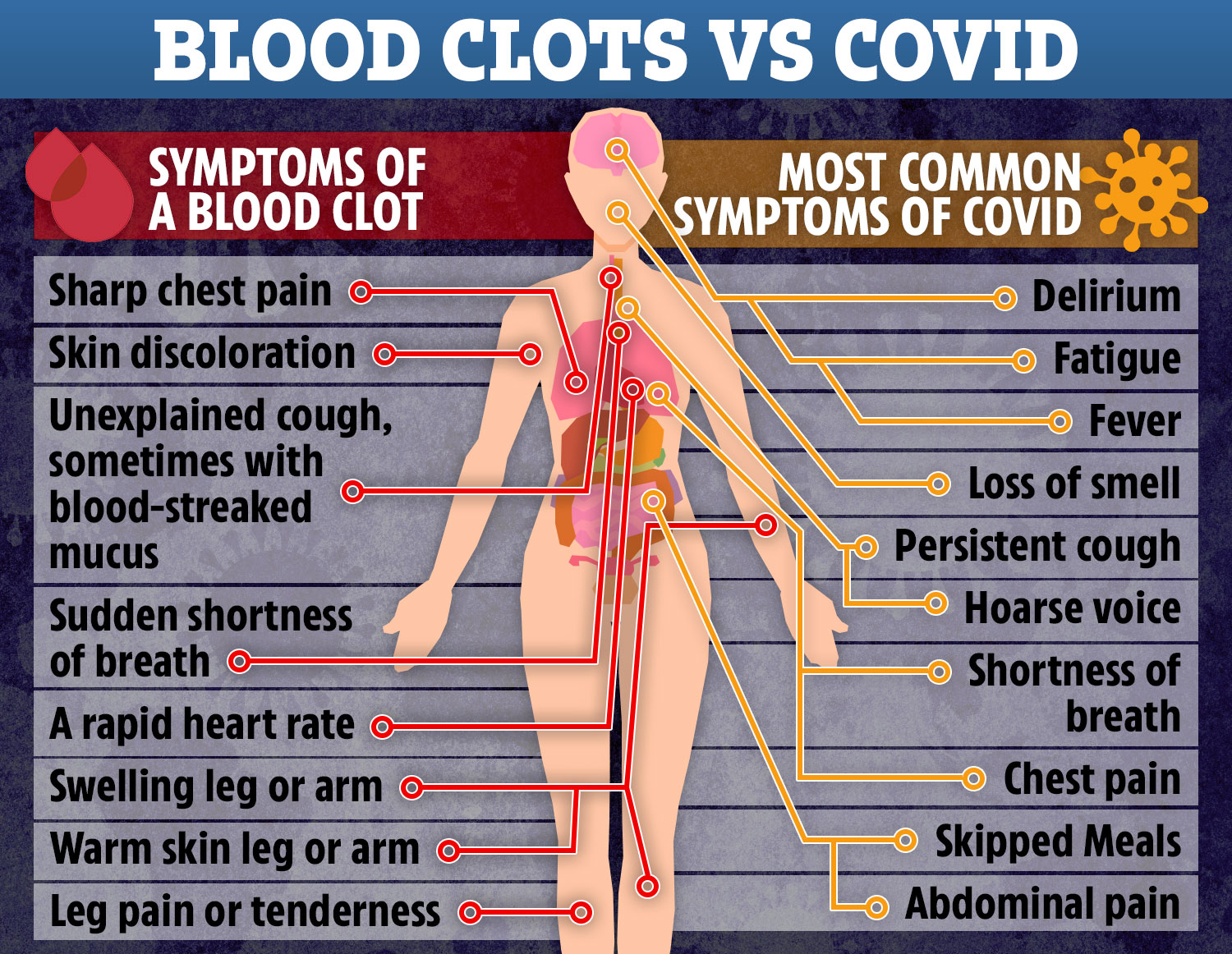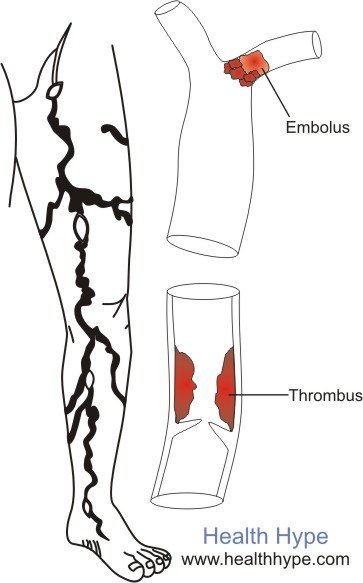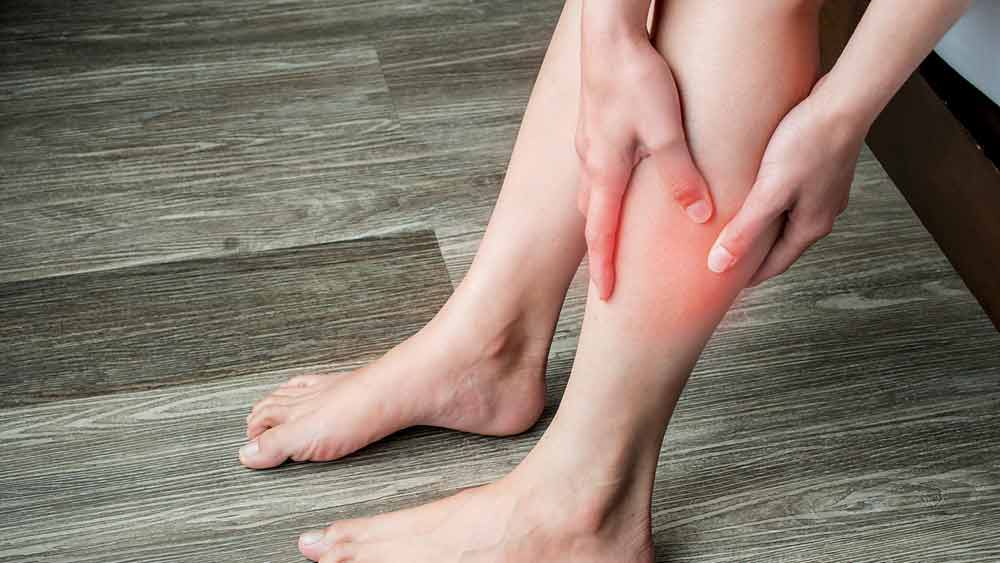Blood clot in right leg symptoms. Blood Clot in Right Leg: Symptoms, Causes, and Treatment Options
What are the symptoms of a blood clot in the right leg. How are blood clots diagnosed. What treatments are available for blood clots in the leg. How can you prevent blood clots from forming.
Understanding Blood Clots: Types and Formation
Blood clots are jelly-like masses that form when blood coagulates. While clotting is a crucial process that helps stop bleeding after an injury, sometimes clots can form inappropriately or fail to dissolve, leading to serious health complications. There are two main types of blood clots:
- Thrombus: A stationary clot that forms and remains in one location, potentially blocking blood flow.
- Embolus: A clot that breaks free and travels through the bloodstream, potentially lodging in another part of the body.
Blood clots can form in various parts of the body, including arteries and veins in the heart, brain, lungs, abdomen, arms, and legs. The location of the clot determines the specific symptoms and potential health risks.

Arterial vs. Venous Clots
Blood clots are further classified based on where they initially form:
- Arterial clots: Form in arteries, which carry blood away from the heart. These clots can quickly lead to tissue damage by blocking blood and oxygen supply to vital organs.
- Venous clots: Develop in veins, often more slowly. They can be harder to detect initially but can still cause significant problems.
Recognizing Blood Clot Symptoms in the Right Leg
When a blood clot forms in the right leg, it’s crucial to identify the symptoms early. Common signs of a blood clot in the leg include:
- Swelling in the affected leg
- Pain or tenderness, often described as a cramping sensation
- Warm skin in the area of the clot
- Redness or discoloration of the skin
- A feeling of heaviness in the leg
Is leg pain always indicative of a blood clot? Not necessarily. While leg pain can be a symptom of a blood clot, it can also be caused by other conditions. However, if you experience persistent leg pain accompanied by swelling, warmth, and redness, it’s important to seek medical attention promptly.
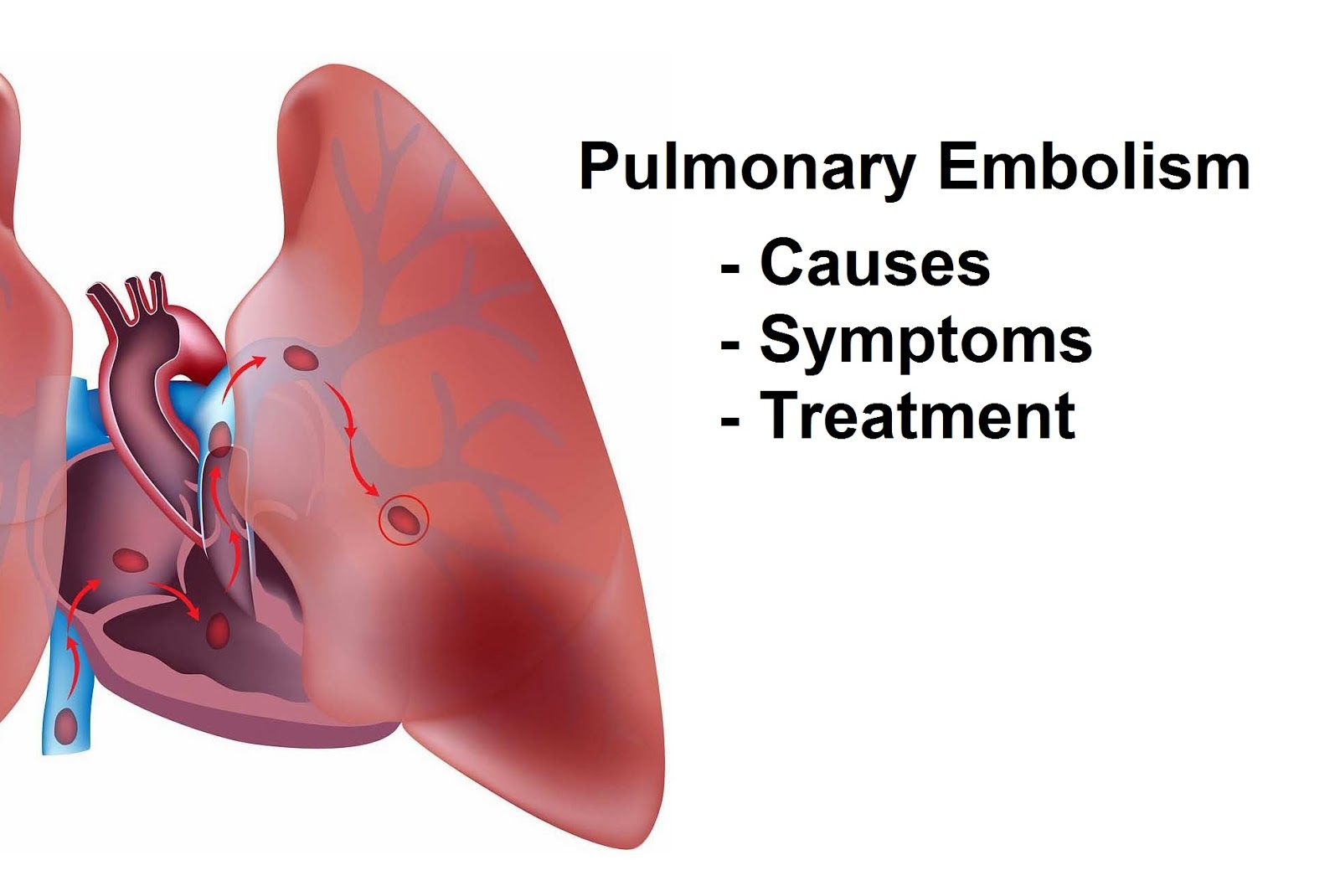
Deep Vein Thrombosis: A Serious Concern
Deep Vein Thrombosis (DVT) is a type of blood clot that forms in the deep veins of the body, often in the legs. DVT is a serious condition that requires immediate medical attention. Symptoms of DVT in the right leg may include:
- Swelling of the entire leg or along a vein in the leg
- Pain or tenderness in the leg, which may be felt only when standing or walking
- Increased warmth in the area of the leg that’s swollen or painful
- Red or discolored skin on the leg
Can DVT resolve on its own? While some small blood clots may dissolve naturally, it’s never safe to assume a suspected DVT will go away without treatment. Untreated DVT can lead to serious complications, including pulmonary embolism, a potentially life-threatening condition where a clot travels to the lungs.
Causes and Risk Factors for Blood Clots
Understanding the causes and risk factors for blood clots can help in prevention and early detection. Some common factors that increase the risk of developing blood clots include:

- Extended periods of inactivity (e.g., long flights, bed rest)
- Recent surgery or injury
- Obesity
- Smoking
- Hormonal changes (e.g., pregnancy, use of birth control pills)
- Certain medical conditions (e.g., cancer, heart disease)
- Family history of blood clots
- Age (risk increases with age)
Do all risk factors carry the same weight? Not all risk factors contribute equally to the likelihood of developing a blood clot. Some factors, such as prolonged immobility following surgery or a major injury, pose a higher risk than others. It’s important to discuss your individual risk factors with a healthcare provider.
Diagnosing Blood Clots in the Right Leg
If a blood clot in the right leg is suspected, prompt diagnosis is crucial. Healthcare providers may use several methods to confirm the presence of a clot:
- Physical examination: The doctor will check for swelling, tenderness, and changes in skin color.
- Duplex ultrasound: This non-invasive imaging test uses sound waves to visualize blood flow in the veins.
- D-dimer blood test: This test measures a substance released when a blood clot breaks down.
- Venography: A contrast dye is injected into the veins, and X-rays are taken to visualize blood flow.
- CT scan or MRI: These imaging tests can provide detailed images of blood vessels and potential clots.
How accurate are these diagnostic methods? While no single test is 100% accurate, combining multiple diagnostic approaches significantly increases the likelihood of correctly identifying a blood clot. Duplex ultrasound is often the first-line test due to its non-invasive nature and high accuracy in detecting clots in leg veins.
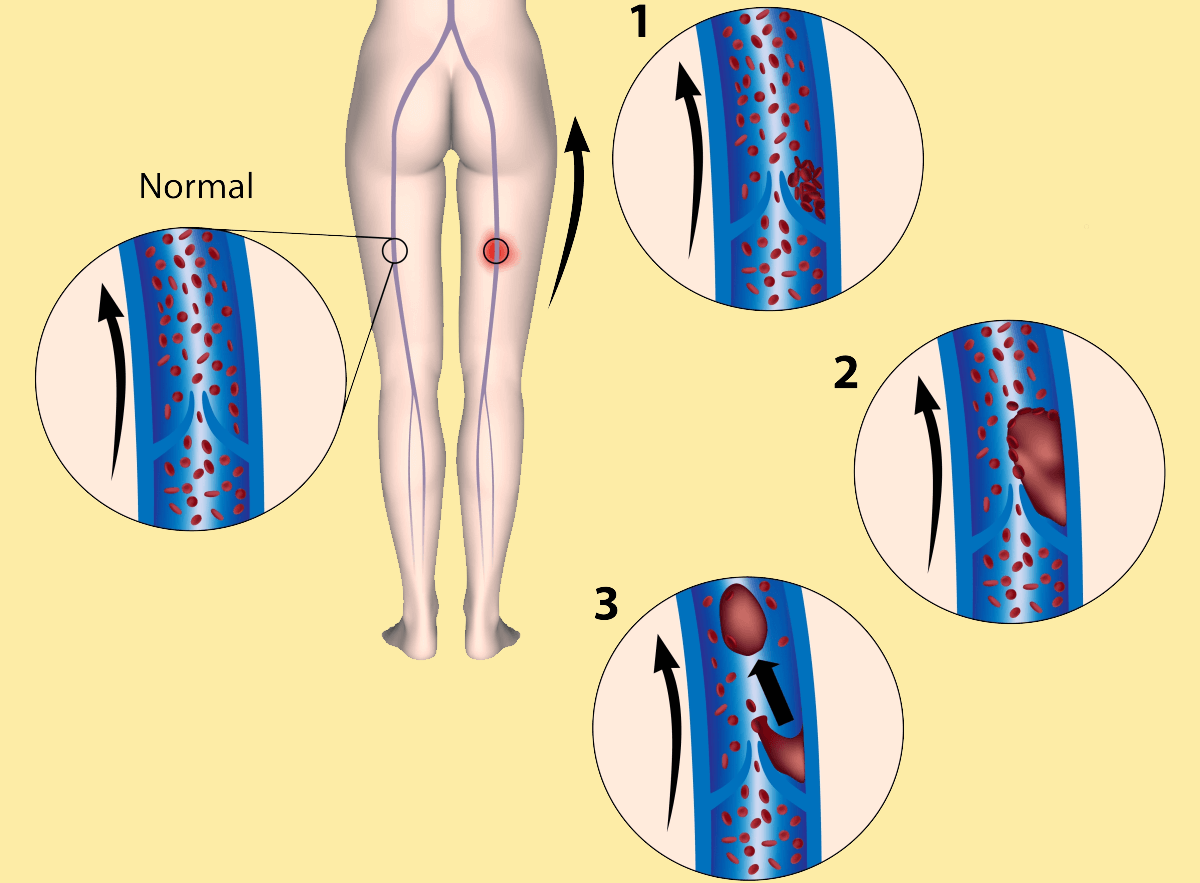
Treatment Options for Blood Clots
Once a blood clot is diagnosed, treatment typically focuses on preventing the clot from growing larger and reducing the risk of new clots forming. Common treatment options include:
- Anticoagulants (blood thinners): Medications like heparin and warfarin help prevent clots from growing and new ones from forming.
- Thrombolytics: These powerful drugs can dissolve existing clots but are typically reserved for severe cases due to bleeding risks.
- Compression stockings: These tight-fitting socks help improve blood flow in the legs and reduce swelling.
- Inferior vena cava (IVC) filter: In some cases, a filter may be placed in a large vein to catch blood clots before they reach the lungs.
- Lifestyle changes: Quitting smoking, maintaining a healthy weight, and staying active can help prevent future clots.
How long does treatment for a blood clot typically last? The duration of treatment can vary depending on the size and location of the clot, as well as individual risk factors. Some people may need to take blood thinners for several months, while others with recurrent clots may require lifelong treatment. Regular follow-ups with a healthcare provider are essential to monitor progress and adjust treatment as needed.
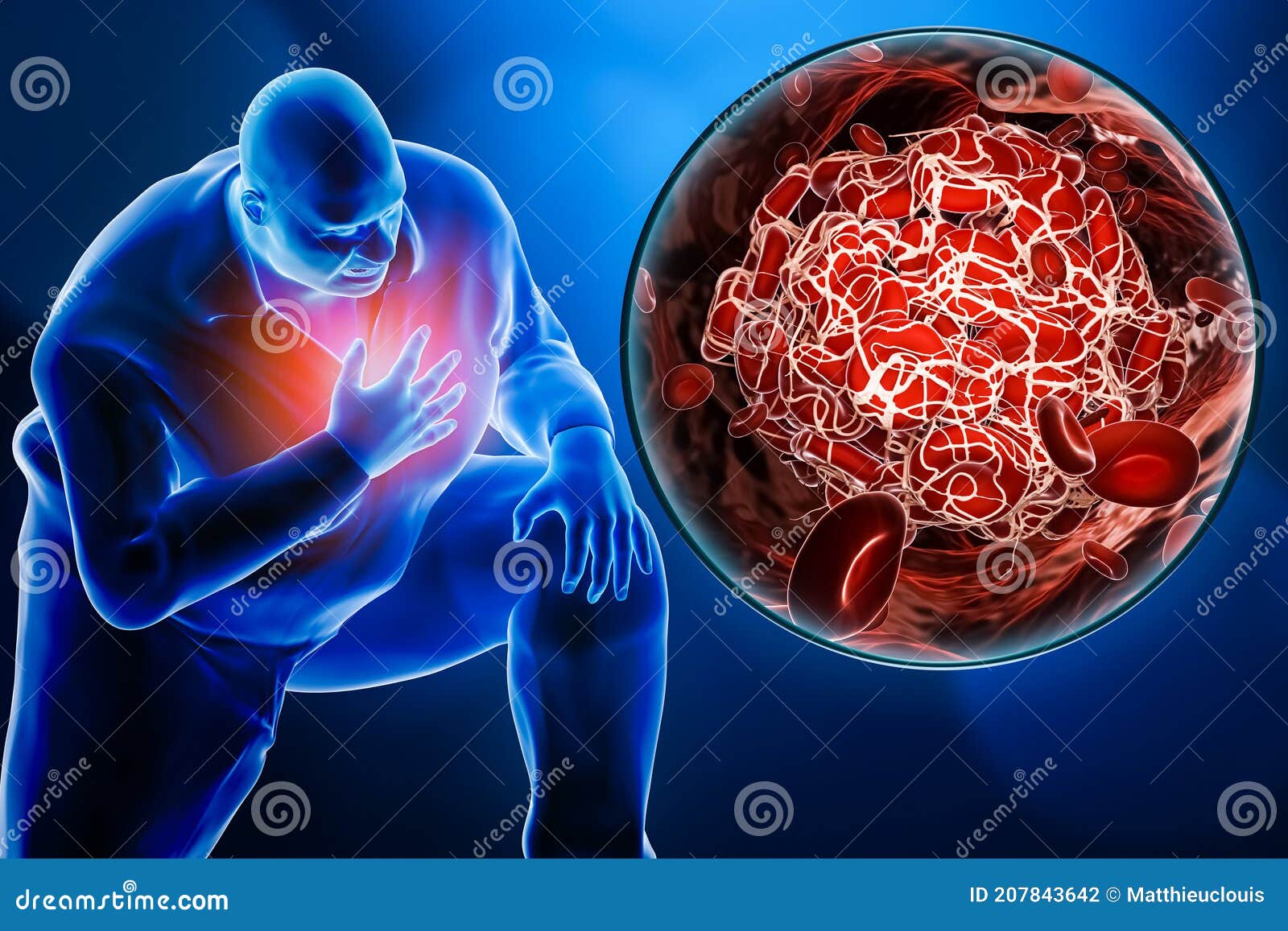
Preventing Blood Clots: Strategies for Reducing Risk
While not all blood clots can be prevented, there are several strategies that can help reduce your risk:
- Stay active: Regular exercise improves circulation and helps prevent blood from pooling in the legs.
- Maintain a healthy weight: Obesity is a significant risk factor for blood clots.
- Stay hydrated: Proper hydration helps maintain blood volume and reduces the risk of clot formation.
- Avoid prolonged periods of immobility: If you’re on a long flight or confined to bed rest, try to move your legs regularly or use compression stockings.
- Manage underlying health conditions: Conditions like high blood pressure and diabetes can increase clot risk, so keeping them under control is important.
- Consider preventive measures during high-risk periods: Talk to your doctor about using blood thinners or compression stockings during periods of increased risk, such as after surgery.
Are there any natural remedies that can help prevent blood clots? While some natural substances like omega-3 fatty acids and certain herbs have been suggested to have blood-thinning properties, it’s crucial to consult with a healthcare provider before using any natural remedies, especially if you’re already taking prescribed medications. Natural remedies should not be considered a substitute for proven medical treatments or preventive measures.
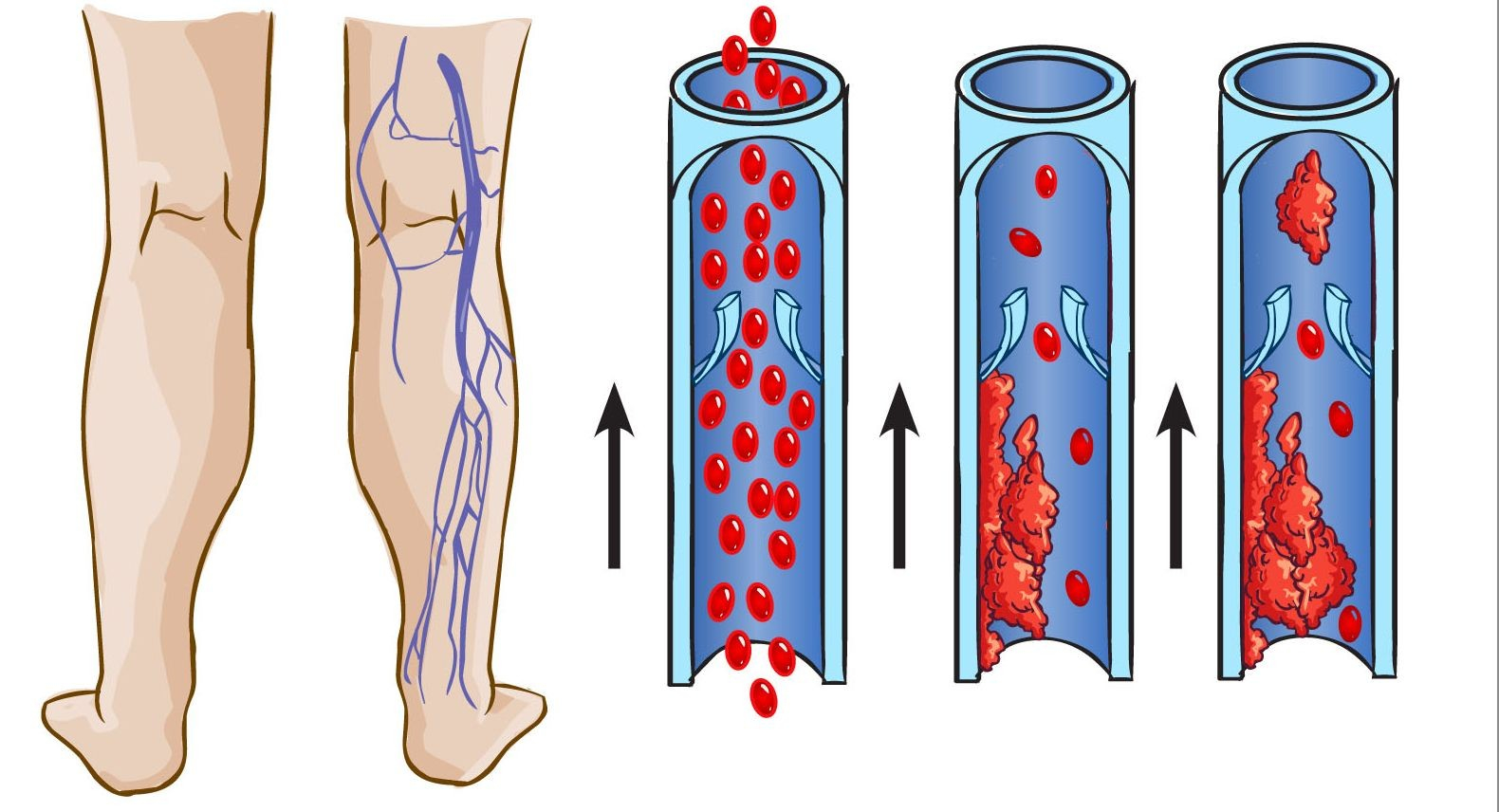
When to Seek Medical Attention for Suspected Blood Clots
Recognizing the signs of a potential blood clot and seeking prompt medical attention can be life-saving. You should seek immediate medical care if you experience:
- Sudden swelling in one leg
- Unexplained pain or tenderness in the leg
- Warm or red skin on the affected leg
- Shortness of breath or chest pain (which could indicate a pulmonary embolism)
Is it possible to have a blood clot without any symptoms? Yes, it is possible to have a blood clot without noticeable symptoms, especially in the early stages. This is one reason why understanding and managing your risk factors is crucial. If you have multiple risk factors for blood clots, regular check-ups with your healthcare provider can help detect potential issues early.
Blood clots in the right leg, or any part of the body, are serious medical conditions that require prompt attention and treatment. By understanding the symptoms, causes, and risk factors associated with blood clots, individuals can take proactive steps to reduce their risk and seek timely medical care when needed. Remember, early detection and treatment of blood clots can significantly improve outcomes and prevent potentially life-threatening complications.

Types of Blood Clots
Blood clots are jelly-like masses of blood. They can occur in arteries or veins in your heart, brain, lungs, abdomen, arms, and legs.
You need your blood to clot when you’re cut or injured. It helps stop bleeding. Most of the time, your body breaks down the clot after your wound has healed. But sometimes, they don’t dissolve on their own. When this happens, it can lead to serious health problems.
There are two main types of clots:
- Thrombus:Blood clots can be stationary. That means they don’t move. But they can block blood flow. Doctors call this type of clot a thrombosis.
- Embolus: Blood clots can also break loose. Doctors call these embolisms. They’re dangerous because they can travel to other parts of the body
Symptoms differ depending on the location of the clot. In some cases, the clot may have formed in one place (thrombus), in others, it might have broken off and moved elsewhere through your blood (embolus).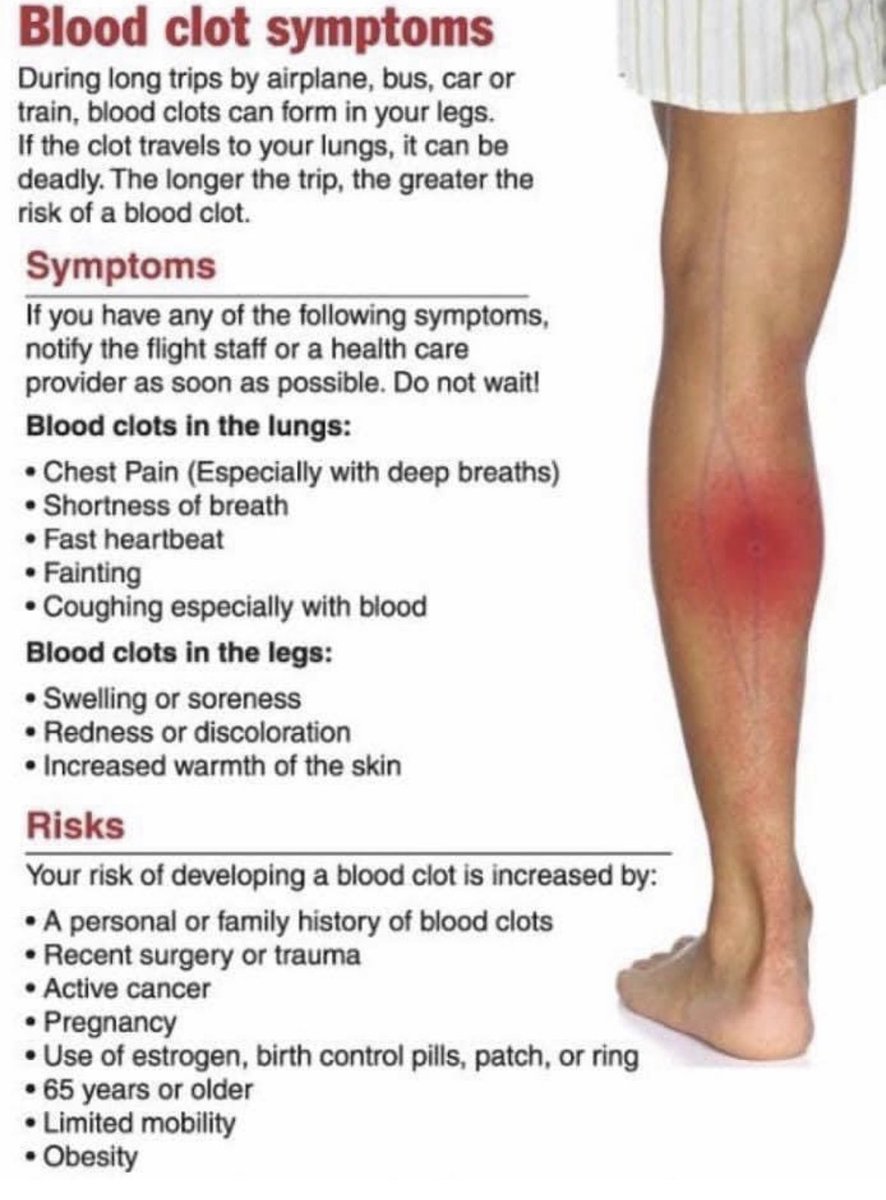
- Arms or legs: Red and warm where clot is. Swelling, tenderness, and pain like an intense cramp.
- Abdomen: Serious stomach pain, diarrhea, and vomiting.
- Heart:Breathing problems, nausea, dizziness, sweating, or pain and heaviness in the chest.
- Lungs: You may cough up blood and notice a racing heart, shortness of breath, sweating, fever, and sharp chest pain.
- Brain:Headache, dizziness, and difficulty with talking and seeing clearly. You also may notice weakness in your face, arms, or legs.
Clots are also classified by where they form in the first place.
Arterial Clot
These form in your arteries — the blood vessels that carry blood away from your heart.
Arterial clots block blood and oxygen from reaching your vital organs. They can lead to tissue damage.
Often, they occur in your legs and feet. Sometimes, they happen in your brain, where they can lead to stroke.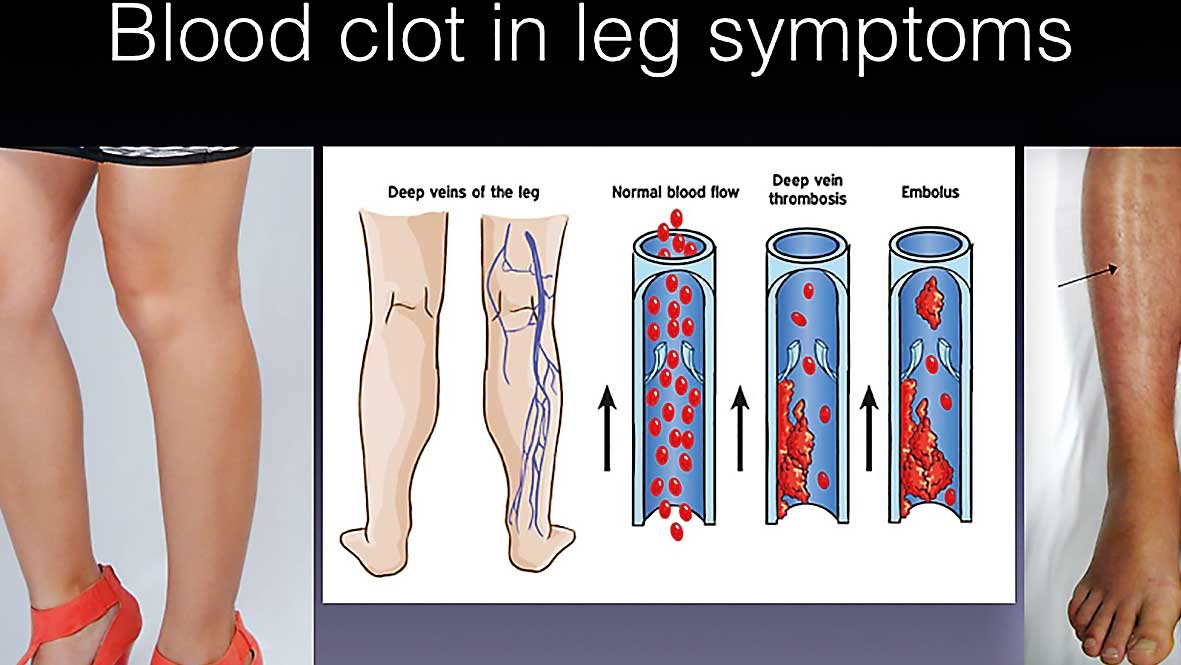 Or, they may form in your heart, where they can cause a heart attack.
Or, they may form in your heart, where they can cause a heart attack.
Arterial clots can also take root in your kidneys, intestines, or eyes, though this is rare.
Symptoms
You may not have any at first. As the clot grows or blocks more of your blood flow, you might notice any of the following:
- Cold arm or leg
- Fingers or hands that feel cool to the touch
- Muscle pain or spasm in the affected area
- Numbness or tingling in your arm or leg
- Weakness of the affected limb
- Loss of color in the affected limb
Venous Clots
These form in your veins. They tend to develop slowly. That’s why you might not know you have one until it causes problems.
There are three types of blood clots that form in the veins — superficial venous thrombosis, deep vein thrombosis (DVT), and pulmonary embolism (PE).
Superficial venous thrombosis. This is a blood clot that forms in a vein close to the surface of the skin.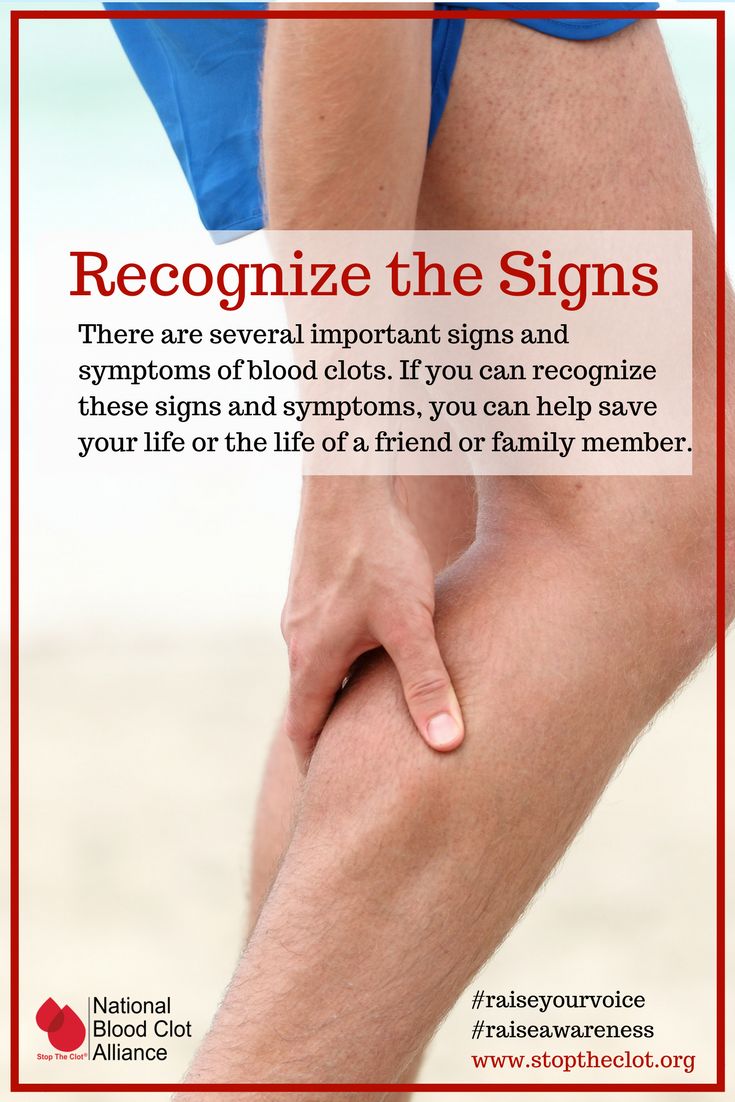 They don’t normally break loose and travel through the bloodstream. But they can be painful and need treatment.
They don’t normally break loose and travel through the bloodstream. But they can be painful and need treatment.
DVT, or deep vein thrombosis. This is also called a “venous thrombosis.” It’s a blood clot that forms in a major vein deep in your body. It usually happens in your lower leg, thigh, or pelvis. But it can also form in other parts of your body, like your arm, brain, intestines, liver, or kidney.
Pulmonary embolism. This type of blood clot is a medical emergency. It’s a DVT that breaks off and travels up your leg to your lungs, where it gets stuck. It can be fatal.
Symptoms
If your vein is near your skin’s surface (superficial venous thrombosis), these may include:
- Painful, swollen, inflamed skin over the affected vein
- A vein that feels hard or painfully tender to the touch
- Red skin over the affected vein
If you have a DVT, you may notice the following:
- The affected leg is swollen (sometimes both legs swell).

- You have a cramping pain or soreness in your leg, usually in the calf. It may be worse when you bend your foot back toward your knee.
- There’s an aching, heavy feeling in the affected leg.
- The skin in the area of the clot is warm or red.
A DVT is a medical emergency. See your doctor right away if you notice these symptoms.
Left untreated, a DVT can turn into a pulmonary embolism. Call 911 if you have pain, swelling, or tenderness in your leg, and:
- You can’t breathe.
- You have chest pain.
Causes, Diagnosis, Treatment, and Prevention
What Is a Charley Horse?
A charley horse is a muscle spasm — when a muscle suddenly tightens up on its own. These cramps can happen anywhere in your body. They’re common in your legs.
Charley Horse Causes
Things that can trigger a charley horse include:
Muscle cramps are also a side effect of some drugs, such as:
- Furosemide (Lasix), hydrochlorothiazide (Microzide), and other diuretics (“water pills”) that take fluid out of your body
- Donepezil (Aricept), used to treat Alzheimer’s disease
- Neostigmine (Prostigmine), used for myasthenia gravis
- Nifedipine (Procardia), a treatment for angina and high blood pressure
- Raloxifene (Evista), an osteoporosis treatment
- Asthma medications terbutaline (Brethine) and albuterol (Proventil, Ventolin)
- Tolcapone (Tasmar), which helps treat Parkinson’s disease
- Statin medications for cholesterol, such as atorvastatin (Lipitor), fluvastatin (Lescol), lovastatin (Mevacor), pravastatin (Pravachol), rosuvastatin (Crestor), or simvastatin (Zocor)
Charley Horse Risk Factors
Certain people tend to get charley horses more often:
Charley Horse Diagnosis
You don’t need to see your doctor unless you have a charley horse along with one of these conditions:
Your doctor will ask about your symptoms and medical history.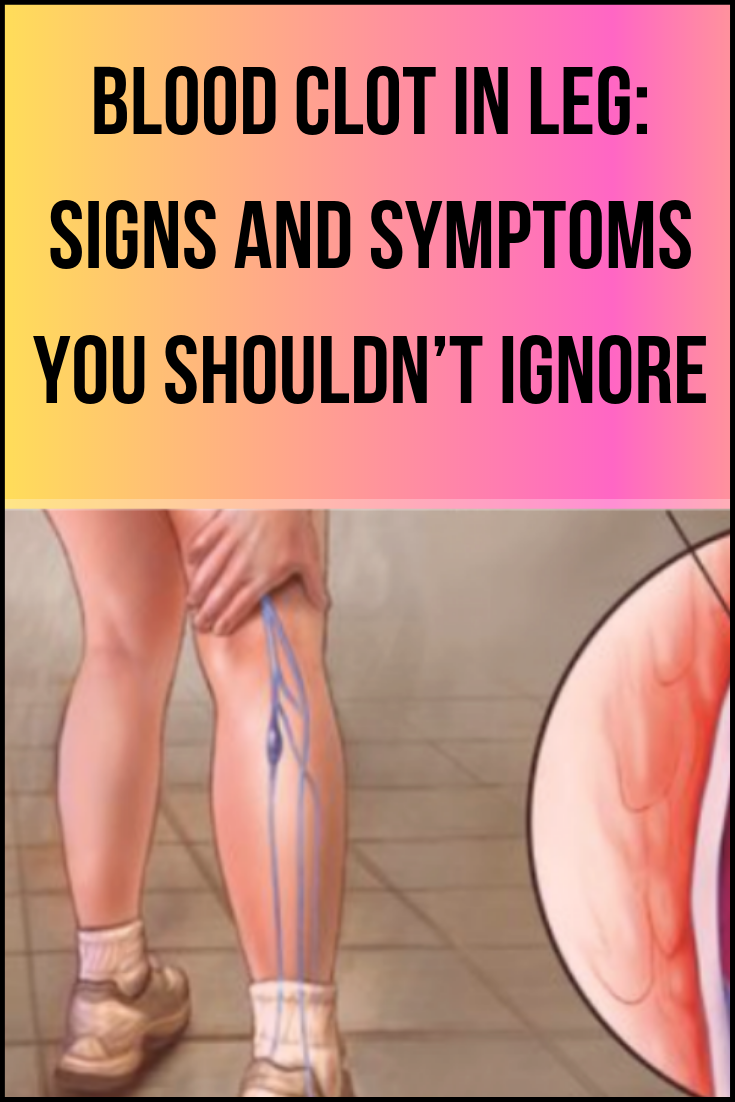 They’ll also do a physical exam. They might order blood tests, muscle tests, or MRI exams to look for a health condition that can cause cramps.
They’ll also do a physical exam. They might order blood tests, muscle tests, or MRI exams to look for a health condition that can cause cramps.
Charley Horse Treatment
If you get a charley horse in your calf or in the back of your thigh (hamstring), put your weight on the affected leg and bend your knee slightly. Or sit or lie down with your leg out straight and pull the top of your foot toward your head.
For a cramp in the front of your thigh (quadriceps), hold on to a chair and bend the knee of the affected leg. Pull your foot up toward your buttock.
Massage, a bath with Epsom salts, or a heating pad can relax the muscle. To fight pain, use an ice pack or take an over-the-counter medication like ibuprofen or naproxen.
In most cases, the charley horse will stop within a few minutes. But if you get them often and for no clear reason, tell your doctor.
Charley Horse Prevention
To help stop cramps before they start:
- Eat more foods high in vitamins and magnesium.

- Stay hydrated.
- Stretch daily and before exercise. Stretching before exercise can help prevent tight muscles. Daily stretching can help with cramps caused by other things.
- Wear comfortable shoes.
- Limit how much alcohol you drink.
- Ramp up your exercise slowly rather than all at once.
- Don’t exercise right after you eat.
- Don’t smoke.
Signs and Symptoms of Blood Clots
Signs and Symptoms of Blood Clots: Deep Vein Thrombosis (DVT) and Pulmonary Embolism (PE)
Deep Vein Thrombosis:
Signs and Symptoms
Deep vein thrombosis (DVT) occurs when a blood clot forms in one of the deep veins of your body, usually in your legs, but sometimes in your arm. The signs and symptoms of a DVT include:
- Swelling, usually in one leg (or arm)
- Leg pain or tenderness often described as a cramp or Charley horse
- Reddish or bluish skin discoloration
- Leg (or arm) warm to touch
These symptoms of a blood clot may feel similar to a pulled muscle or a “Charley horse,” but may differ in that the leg (or arm) may be swollen, slightly discolored, and warm.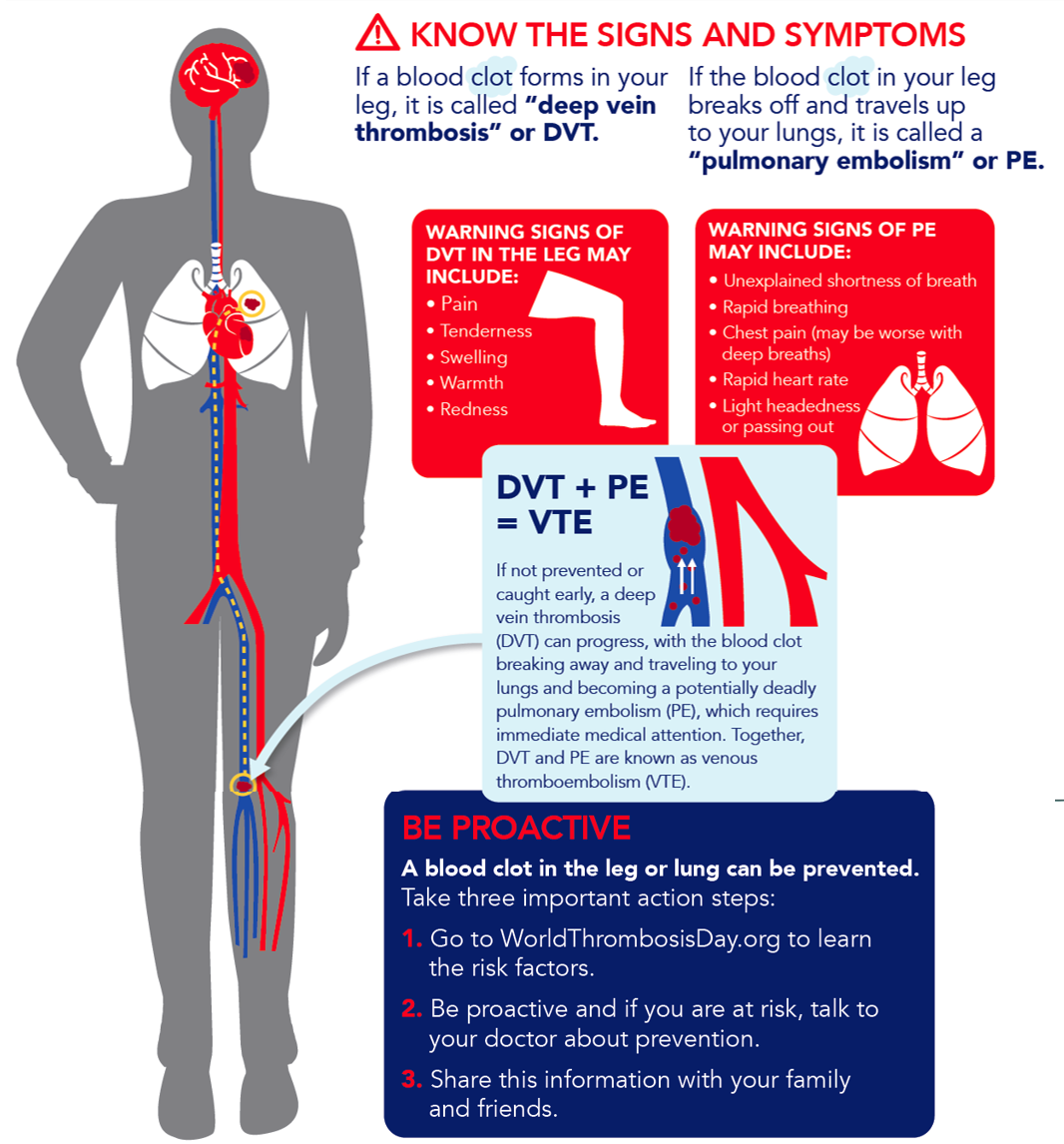
Contact your doctor as soon as you can if you have any of these symptoms, because you may need treatment right away. If you need help finding a doctor, please click here.
Learn more about how a DVT is diagnosed here.
Pulmonary Embolism:
Signs and Symptoms
Clots can break off from a DVT and travel to the lung, causing a pulmonary embolism (PE), which can be fatal. The signs and symptoms of a PE include:
- Sudden shortness of breath
- Chest pain-sharp, stabbing; may get worse with deep breath
- Rapid heart rate
- Unexplained cough, sometimes with bloody mucus
Call an ambulance or 911 immediately for treatment in the ER if you experience these PE symptoms.
Learn more about how a PE is diagnosed here.
Blood Clot Awareness Stop the Clot® Acronym
Share our Blood Clot Awareness Stop the Clot® acronym to highlight the signs and symptoms of blood clots. Knowing can save your life or the life of someone you know.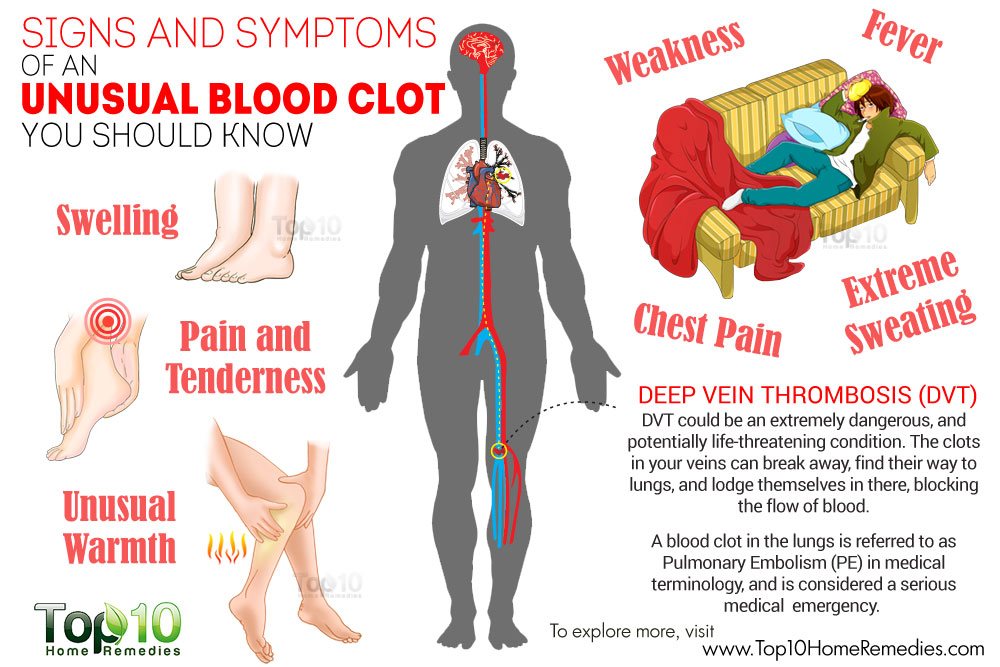 Download a PDF version here.
Download a PDF version here.
Learn More and Get Involved
Learn more about life-saving information about blood clots here.
Learn how you can help and support NBCA’s mission or donate now.
DVT (deep vein thrombosis) – NHS
DVT (deep vein thrombosis) is a blood clot in a vein, usually the leg. DVT can be dangerous. Get medical help as soon as possible if you think you have DVT.
Urgent advice: Ask for an urgent GP appointment or call 111 if:
You think you have DVT.
Symptoms of DVT in the leg are:
- throbbing or cramping pain in 1 leg (rarely both legs), usually in the calf or thigh
- swelling in 1 leg (rarely both legs)
- warm skin around the painful area
- red or darkened skin around the painful area
- swollen veins that are hard or sore when you touch them
These symptoms also happen in your arm or tummy if that’s where the blood clot is.
What DVT in a leg can look like
Red and swollen right leg caused by DVT
Credit:
Who is more likely to get DVT
A DVT is more likely to happen if you:
- are over 60
- are overweight
- smoke
- have had DVT before
- take the contraceptive pill or HRT
- have cancer or heart failure
- have varicose veins
There are also some temporary situations when you’re at more risk of DVT. These include if you:
- are staying in or recently left hospital – especially if you cannot move around much (like after an operation)
- are confined to bed
- go on a long journey (more than 3 hours) by plane, car or train
- are pregnant or if you’ve had a baby in the previous 6 weeks
- are dehydrated
Sometimes DVT can happen for no obvious reason.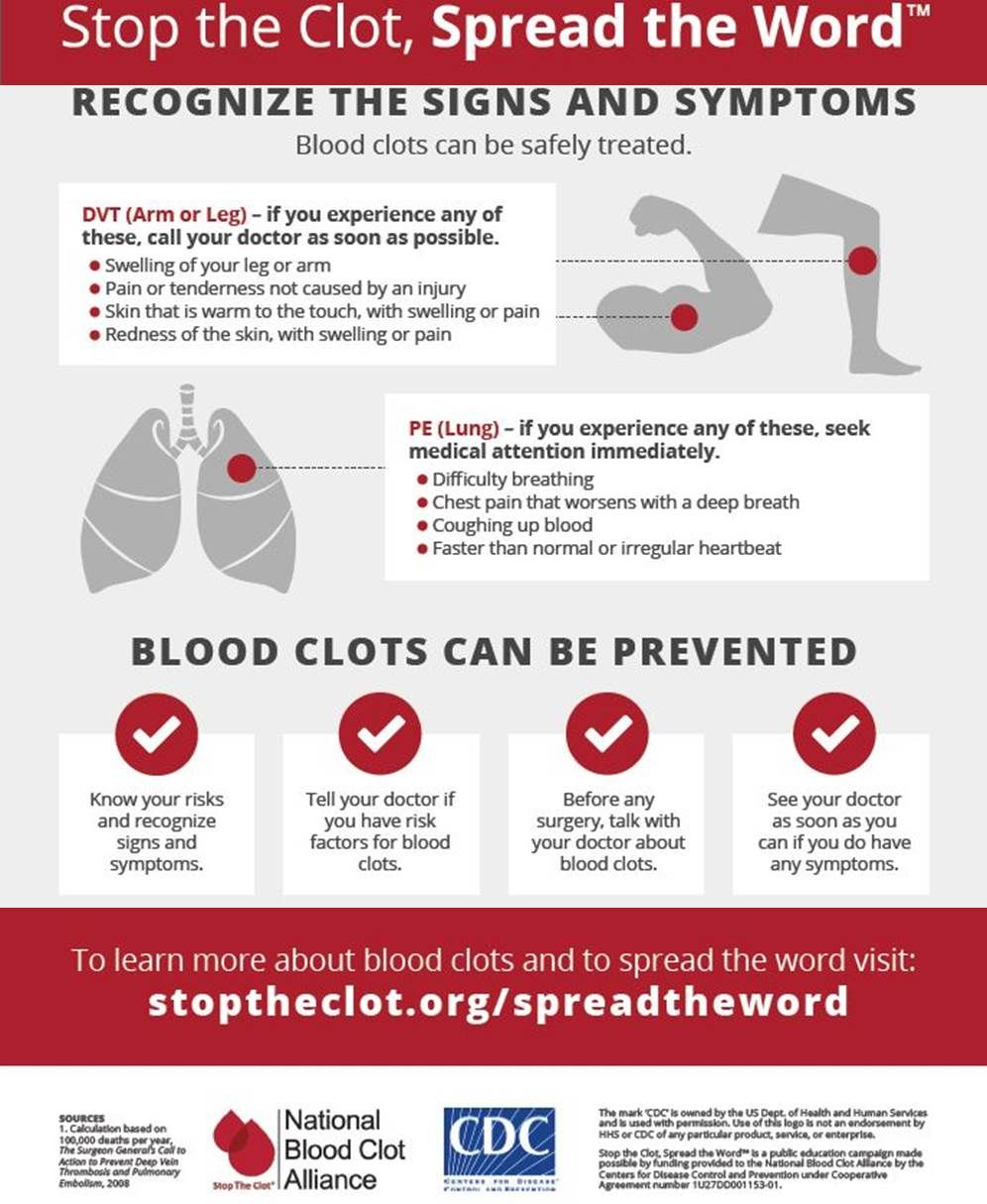
How DVT is diagnosed
If a doctor thinks you have DVT, you should be referred to hospital within 24 hours for an ultrasound scan. The scan shows whether blood is flowing normally through the vein.
You may also have an X-ray of the vein (venogram). For this, you will be injected with a dye to show where the blood clot is.
Treatment of DVT
You may have an injection of an anticoagulant (blood thinning) medicine called heparin while you’re waiting for an ultrasound scan to tell if you have a DVT.
After DVT is diagnosed, the main treatment is tablets of an anticoagulant medicine, such as warfarin and rivaroxaban. You will probably take the tablets for at least 3 months.
If anticoagulant medicines are not suitable, you may have a filter put into a large vein – the vena cava – in your tummy. The filter traps and stops a blood clot travelling to your heart and lungs.
The filter traps and stops a blood clot travelling to your heart and lungs.
A newer treatment involves breaking up and sucking out the clot through a small tube in the vein. You usually need to take anticoagulant medicine for several months after this treatment.
DVT in pregnancy is treated differently. It is treated with anticoagulant injections for the rest of the pregnancy and until the baby is 6 weeks old. Read more about DVT in pregnancy.
Recovery from DVT
Some lifestyle measures will help you recover from DVT.
After you leave hospital, you will be encouraged to:
- walk regularly
- keep your affected leg raised when you’re sitting
- delay any flights or long journeys until at least 2 weeks after you start anticoagulant medicine
Tips to prevent DVT
Don’t
do not sit still for long periods of time – get up and move around every hour or so
do not cross your legs while you’re sitting, it can restrict blood flow
do not smoke – get support to stop smoking
do not drink lots of alcohol
Going on a long journey
If you’re travelling for 3 hours or more by plane, train or car, there are things you can do during the journey to reduce your risk of DVT.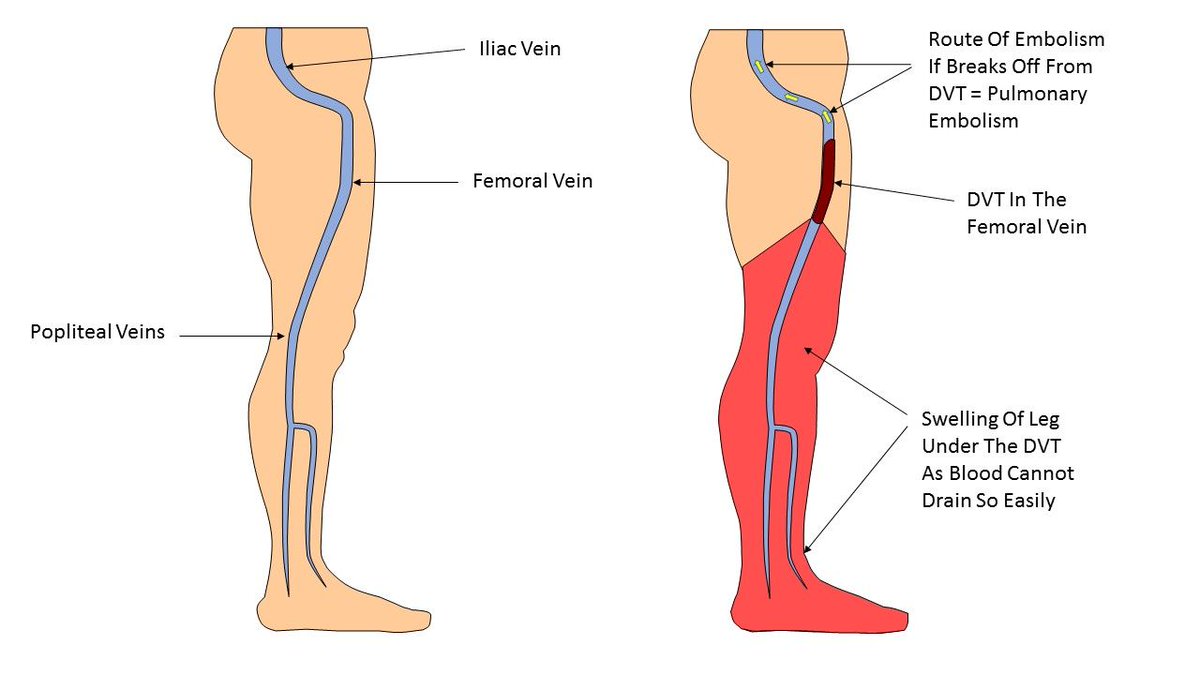 These include drinking plenty of water and avoiding alcohol.
These include drinking plenty of water and avoiding alcohol.
Find out more tips to reduce your risk of travel-related DVT
Going into hospital
If you go into hospital, your healthcare team should check your risks of DVT.
If they think you’re more likely to get DVT, you may be given treatment to prevent it, such as medicine or compression stockings (knee-high elastic socks that help your blood circulation), while you’re in hospital.
You may continue treatment after you leave hospital because a blood clot can happen weeks later.
You can also help protect yourself against DVT while you’re in hospital by:
- staying active and walking around if you can
- moving your toes (up and down) and ankles (in circles) if you have to stay in bed – your healthcare team may give you some exercises to do
Page last reviewed: 23 October 2019
Next review due: 23 October 2022
Deep Vein Thrombosis (DVT); Symptoms, Causes, Treatment & Prevention
Overview
What is deep vein thrombosis?
Deep vein thrombosis (DVT, also called venous thrombosis) is a blood clot that develops in a vein deep in the body.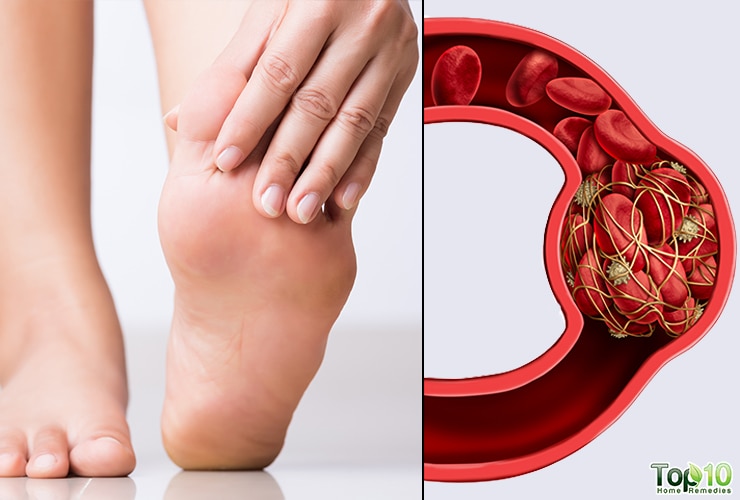 The clot may partially or completely block blood flow through the vein. Most DVTs occur in the lower leg, thigh or pelvis, although they also can occur in other parts of the body including the arm, brain, intestines, liver or kidney.
The clot may partially or completely block blood flow through the vein. Most DVTs occur in the lower leg, thigh or pelvis, although they also can occur in other parts of the body including the arm, brain, intestines, liver or kidney.
What is the danger of DVT?
Even though DVT itself is not life-threatening, the blood clot has the potential to break free and travel through the bloodstream, where it can become lodged in the blood vessels of the lung (known as a pulmonary embolism). This can be a life- threatening condition. Therefore, prompt diagnosis and treatment are necessary.
DVT can also lead to complications in the legs referred to as chronic venous insufficiency or the post-thrombotic syndrome. This condition is characterized by pooling of blood, chronic leg swelling, increased pressure, increased pigmentation or discoloration of the skin, and leg ulcers known as venous stasis ulcers.
What is the difference between DVT and a superficial venous thrombosis?
A superficial venous thrombosis (also called phlebitis or superficial thrombophlebitis) is a blood clot that develops in a vein close to the surface of the skin. These types of blood clots do not usually travel to the lungs unless they move from the superficial system into the deep venous system first.
These types of blood clots do not usually travel to the lungs unless they move from the superficial system into the deep venous system first.
Symptoms and Causes
What are the symptoms of DVT?
A DVT usually forms in one leg or one arm. Not everyone with a DVT will have symptoms, but symptoms can include:
- Swelling of the leg or arm (sometimes this happens suddenly)
- Pain or tenderness in the leg (may only happen when standing or walking)
- The area of the leg or arm that is swollen or hurts may be warmer than usual
- Skin that is red or discolored
- The veins near the skin’s surface may be larger than normal
Symptoms of a pulmonary embolism include:
- Sudden shortness of breath or fast breathing
- Sharp chest pain that often comes with coughing or movement
- Pain in the back
- Cough (sometimes with bloody sputum/phlegm)
- Sweating more than normal
- Fast heartbeat
- Feeling dizzy or fainting
Some people do not know they have a DVT until the clot moves from their leg or arm and travels to their lung.
It is important to call your doctor right away or go to the emergency room if you have symptoms of a pulmonary embolism or DVT. Do not wait to see if the symptoms “go away.” Get treatment right away to prevent serious complications.
What causes a DVT?
The following conditions can increase your risk of a DVT:
- An inherited (genetic) condition that increases your risk of blood clots
- Cancer and some of its treatments (chemotherapy)
- Limited blood flow in a deep vein, due to injury, surgery, or immobilization
- Long periods of inactivity that decrease blood flow, such as:
- Sitting for a long period of time on trips in a car, truck, bus, train or airplane
- Immobility after surgery or a serious injury
- Pregnancy and the first 6 weeks after giving birth
- Being over age 40 (although a DVT can affect people of any age)
- Being overweight
- Taking birth control pills or hormone therapy
- Having a central venous catheter or pacemaker
Diagnosis and Tests
How is DVT diagnosed?
An appointment to find out if you have a DVT includes an exam and review of your medical history.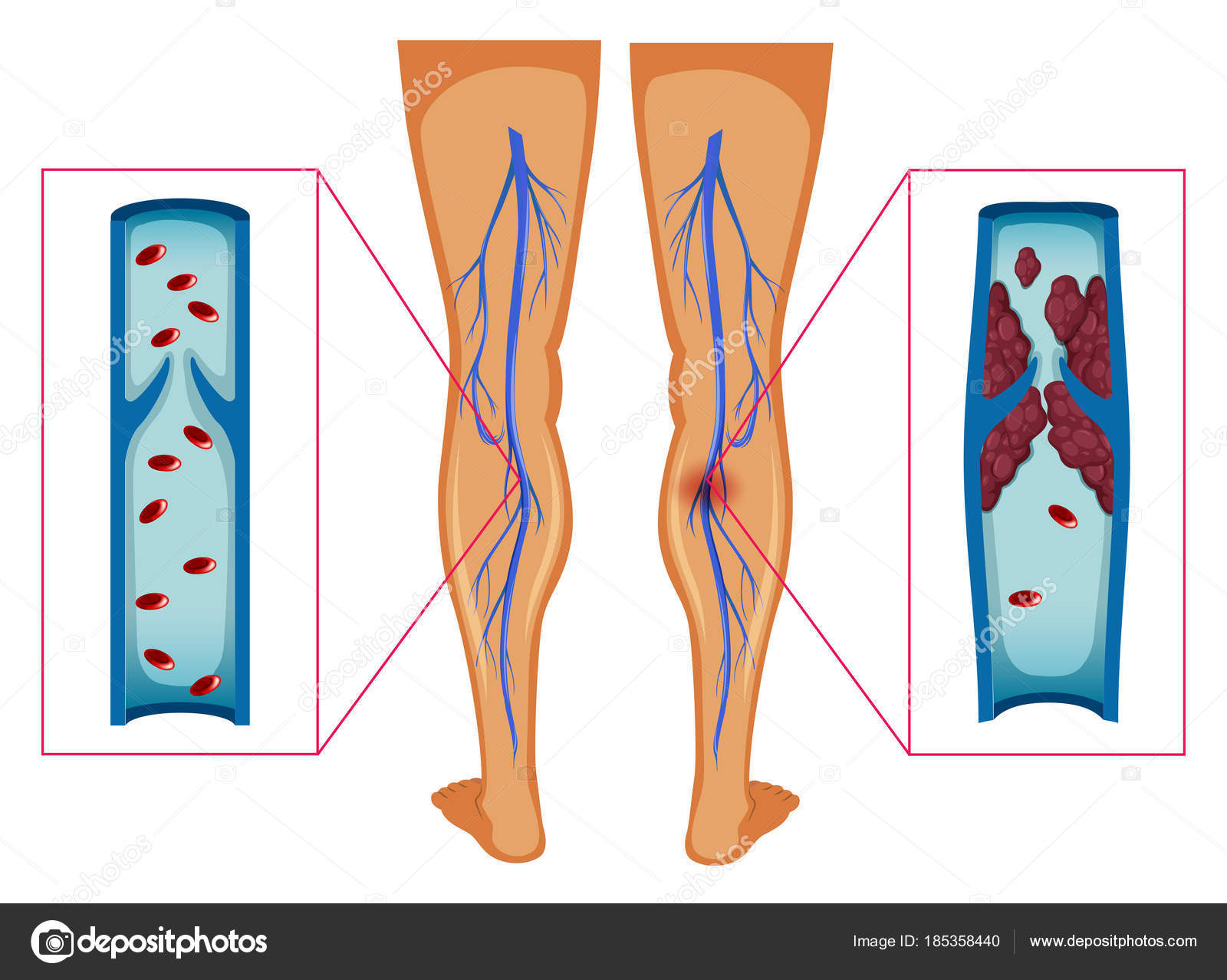 You will also need testing. Common tests to diagnose a DVT are:
You will also need testing. Common tests to diagnose a DVT are:
A duplex venous ultrasound. This is the most common test used to diagnose a DVT. It shows the blood flow in the veins and any blood clots that exist. An ultrasound technician will apply pressure while scanning your arm or leg. If the pressure does not cause the vein to compress, it could mean there is a blood clot.
Venography. This test uses X-rays to show your deep veins. A special dye (contrast material) is injected into your veins so the X-rays show the veins and any blood clots. Any blockage in blood flow may also be seen. Venography may be used if the results of the duplex ultrasound aren’t clear.
Other tests you may have include:
- Magnetic Resonance Imaging (MRI) or Magnetic Resonance Venography (MRV): MRI shows pictures of organs and structures inside the body, and MRV shows pictures of the blood vessels in the body. In many cases, MRI and MRV can offer more information than an X-ray.

- Computed tomography (CT) scan is a type of X-ray that shows structures inside the body. A CT scan may be used to find a DVT in the abdomen or pelvis, as well as blood clots in the lung (pulmonary embolism).
If your doctor thinks you may have a genetic disorder that causes blood clots, you may need blood tests. This may be important if:
- You have a history of blood clots that cannot be linked to any other cause
- You have a blood clot in an unusual location, such as in a vein from the intestines, liver, kidney or brain
- You have a strong family history of blood clots
Management and Treatment
Activity Guidelines
A DVT may make it harder for you to get around at first. You should slowly return to your normal activities. If your legs feel swollen or heavy, lie in bed with your heels propped up about 5 to 6 inches. This helps improve circulation and decreases swelling.
In addition:
- Exercise your lower leg muscles if you are sitting still for long periods of time.

- Stand up and walk for a few minutes every hour while awake.
- Don’t wear tight-fitting clothing that could decrease the circulation in your legs.
- Wear compression stockings as recommended by your doctor.
- Avoid activities that may cause a serious injury.
What treatments are available for patients with a DVT?
Patients with a DVT may need to be treated in the hospital. Others may be able to have outpatient treatment.
Treatments include medications, compression stockings and elevating the affected leg. If the blood clot is extensive, you may need more invasive testing and treatment. The main goals of treatment are to:
- Stop the clot from getting bigger
- Prevent the clot from breaking off in your vein and moving to your lungs
- Reduce the risk of another blood clot
- Prevent long-term complications from the blood clot (chronic venous insufficiency).
Medications
Important Information About Medications
- Take your medications exactly as your doctor tells you to.

- Have blood tests as directed by your doctor and keep all scheduled laboratory appointments.
- Do not stop or start taking any medication (including nonprescription/over-the-counter medications and supplements) without asking your doctor.
- Talk to your doctor about your diet. You may need to make changes, depending on the medication you take.
Treatment for a DVT can include:
Anticoagulants (“blood thinners”). This type of medication makes it harder for your blood to clot. Anticoagulants also stop clots from getting bigger and prevent blood clots from moving. Anticoagulants do not destroy clots. Your body may naturally dissolve a clot, but sometimes clots do not completely disappear.
There are different types of anticoagulants. Your doctor will talk to you about the best type of medication for you.
If you need to take an anticoagulant, you may only need to take it for 3 to 6 months. But, your treatment time may be different if:
- You have had clots before, your treatment time may be longer.

- You are being treated for another illness (such as cancer), you may need to take an anticoagulant as long as your risk of a clot is higher.
The most common side effect of anticoagulants is bleeding. You should call your doctor right away if you notice that you bruise or bleed easily while taking this medication.
Compression Stockings
You will likely need to wear graduated compression stockings to get rid of leg swelling. The swelling is often because the valves in the leg veins are damaged or the vein is blocked by the DVT.Most compression stockings are worn just below the knee. These stockings are tight at the ankle and become more loose as they go up the leg. This causes gentle pressure (compression) on your leg.
DVT Treatment Procedures
Vena cava filters are used when you cannot take medications to thin your blood or if you have blood clots while taking this type of medication. The filter prevents blood clots from moving from the vein in your legs to the lung (pulmonary embolism). The filter is put in place during minor surgery. It is inserted through a catheter into a large vein in the groin or neck, then into the vena cava (the largest vein in the body). Once in place, the filter catches clots as they move through the body. This treatment helps prevent a pulmonary embolism, but does not prevent the formation of more clots.
Prevention
Can a DVT be prevented?
After you have a DVT, you will need to reduce your risk of future clots by:
- Taking your medications exactly as your doctor tells you to.
- Keeping your follow-up appointments with your doctor and the laboratory. These are needed to see how well your treatment is working.
If you have never had a DVT , but have an increased risk of developing one, be sure to:
- Exercise your lower leg muscles if you need to sit still for a long time. Stand up and walk at least every half hour if you are on a long flight. Or get out of the car every hour if you are on a long road trip.
- Get out of bed and move around as soon as you can after you are sick or have surgery. The sooner you move around, the less chance you have of developing a clot.
- Take medications or use compression stockings after surgery (if prescribed by your doctor) to reduce your risk of a clot.
- Follow-up with your doctor as directed to and follow your doctor’s recommendations to reduce your risk of a clot.
Resources
Doctors vary in quality due to differences in training and experience; hospitals differ in the number of services available. The more complex your medical problem, the greater these differences in quality become and the more they matter.
Clearly, the doctor and hospital that you choose for complex, specialized medical care will have a direct impact on how well you do. To help you make this choice, please review our Miller Family Heart, Vascular & Thoracic Institute Outcomes.
Cleveland Clinic Heart, Vascular & Thoracic Institute Vascular Medicine Specialists and Surgeons
Choosing a doctor to treat your vascular disease depends on where you are in your diagnosis and treatment. The following Heart, Vascular & Thoracic Institute Sections and Departments treat patients with all types of vascular disease, including blood clotting disorders:
Section of Vascular Medicine: for evaluation, medical management or interventional procedures to treat vascular disease. In addition, the Non-Invasive Laboratory includes state-of-the art computerized imaging equipment to assist in diagnosing vascular disease, without added discomfort to the patient. Call Vascular Medicine Appointments, toll-free 800-223-2273, extension 44420 or request an appointment online.
Department of Vascular Surgery: surgery evaluation for surgical treatment of vascular disease, including aorta, peripheral artery, and venous disease. Call Vascular Surgery Appointments, toll-free 800-223-2273, extension 44508 or request an appointment online.
You may also use our MyConsult second opinion consultation using the Internet.
The Heart, Vascular & Thoracic Institute also has specialized centers and clinics to treat certain populations of patients:
Learn more about experts who specialize in the diagnosis and treatment of vascular and arterial disease.
Contact
If you need more information, click here to contact us, chat online with a nurse or call the Miller Family Heart, Vascular & Thoracic Institute Resource & Information Nurse at 216.445.9288 or toll-free at 866.289.6911. We would be happy to help you.
Becoming a Patient
Treatment Options
Additional information about vascular treatment options can be found at:
Treatment Guides
Diagnostic Tests
Diagnostic tests are used to diagnose coronary artery disease and the most effective treatment method.
Webchats
Our webchats and video chats give patients and visitors another opportunity to ask questions and interact with our physicians.
Videos
Interactive Tools
Additional information and resources
*A new browser window will open with this link. The inclusion of links to other websites does not imply any endorsement of the material on those websites nor any association with their operators.
Why choose Cleveland Clinic for your care?
Our outcomes speak for themselves. Please review our facts and figures and if you have any questions don’t hesitate to ask.
Top causes of blood clots in the legs and how to avoid them
Don’t let a plane ride or an extended couch potato session put you at risk. Here’s what to do to keep your blood flowing.
Blood clots that form in the deep veins of the legs (deep-vein thrombosis, or DVT) can cause leg symptoms. Worse, the clots can break loose and travel through the blood to the heart and then to the lungs, causing a pulmonary embolism (PE).
More people die from PE each year in the United States than from breast cancer. What causes DVT and PE, what are the symptoms, and how can you prevent them?
Causes and triggers
After your arteries bring oxygen-rich blood to your legs, your veins send the blood back up to your heart and lungs (for more oxygen).
“If blood in the deep leg veins doesn’t move fast enough, or if you have a condition that makes you prone to blood clots, a blood clot can develop,” explains Dr. Sherry Scovell, a vascular surgeon who specializes in venous disease at Harvard-affiliated Massachusetts General Hospital.
Common blood clot triggers include
- being bedridden for long periods because of surgery or illness
- sitting for long periods — even three to four hours — in a car, plane, or train
- getting too little activity and sitting too much
- having blood pool in your legs because valves in a superficial vein don’t work properly (a varicose vein)
- taking a medication that promotes blood clotting.
Your risk for blood clots also increases with older age, a family history of DVT, a previous DVT, cancer, certain genes, COVID-19, heart failure, obesity, pregnancy, sickle cell disease, smoking, spinal cord injury, stroke, untreated varicose veins, and use of birth control pills or hormone replacement therapy.
Symptoms and risks
Be on the lookout for symptoms of two types of blood clots that can form in the legs.
A blood clot in the superficial veins. This is called a superficial venous thrombosis (SVT). “It causes redness, tenderness, or pain over varicose veins,” Dr. Scovell says. “Sometimes, an SVT can grow and become a deep-vein thrombosis.”
A blood clot in the deep leg veins. A DVT usually begins in one leg. “When you get a blockage, the blood can’t leave your leg easily. That leg can become swollen rather suddenly, and painful,” Dr. Scovell says. If your legs don’t normally get swollen, but one leg becomes swollen over a few days, that may be a sign of danger.
If part of that deep-vein clot breaks off and travels to the lungs, a PE occurs. “The clot gets stuck in blood vessels in the lung, you stop getting enough blood flow there, and that part of the lung dies. You have shortness of breath and chest pain when you take in a deep breath,” Dr. Scovell says.
Avoiding blood clots
There are apps available to help you determine your risk for getting a DVT. Dr. Scovell recommends an app called “Caprini DVT Risk,” available on iOS devices, such as an iPhone.
How can you avoid getting a clot when you’re stuck in situations that increase your risk, such as a long car ride? Keep the following tips in mind.
Stay hydrated. Avoid excessive alcohol intake, and drink lots of water.
Stretch your legs. Get up every hour or two and stretch your calves or move your ankles back and forth repeatedly. “The calf muscles act like pumps and propel blood through the veins,” Dr. Scovell says.
Move your legs while you’re lying down. Bend your knees, or point and flex your feet.
Wear compression stockings. They’ll help prevent swelling and keep blood from pooling in the legs.
Pay attention to your position. Avoid crossing your legs, and periodically change your position while seated.
Get an aisle seat when traveling. On a plane, train, or bus, sit in an aisle seat so you can easily get up and move around every few hours.
What if you have symptoms?
If you have new symptoms indicating the possibility of a DVT or a PE, and if you can’t speak immediately to your doctor or nurse, go to the emergency room. “It’s an emergency, not something to check out on Monday if it’s Friday,” Dr. Scovell says.
Treatment typically involves taking a blood thinner for several months or longer. “We also have to figure out why you got the blood clot. If we can’t find a reason, you may need to take a blood thinner for a longer time,” Dr. Scovell says. “And we don’t want you to ever get a blood clot again, so you’ll need to be proactive about avoiding future risks.”
Image: © gradyreese/Getty Images
As a service to our readers, Harvard Health Publishing provides access to our library of archived content.
Please note the date of last review or update on all articles. No content on this site, regardless of date,
should ever be used as a substitute for direct medical advice from your doctor or other qualified clinician.
Symptoms of a DVT in the Thigh
DVT is an acronym for deep vein thrombosis – also called a thrombus, or a blood clot that forms inside a deep vein. Blood clots have the potential to partially or completely block blood flow. They can also break off from the wall of the vessel and travel through blood vessels back to the lung, where it can cause a pulmonary embolism or PE.
Most commonly, a DVT forms in the lower legs (ankles or calves) or the thighs. The DVT can affect both sexes, although the development of blood clots in the thigh is more common in men, usually occurring in individuals over 40 years of age.
Blood clots in the lower extremities or the thigh are commonly caused by pooling of blood in a deep vein. When blood pools in a vein it triggers a number of mechanisms such as blood clotting. Any time potential damage or injury to blood vessel occurs, regardless of how large or small, the body initiates responses to heal that area. The same process occurs when blood pools in a vein.
Pooling of the blood in the lower extremities can be cause by prolonged periods of bedrest, especially after surgical procedure or illness. Bone fractures, stroke or heart attack scenarios, as well as long periods of immobility or activity increase the risk of blood clot development for some.
Signs and Symptoms of the DVT in the thigh
Signs are visible, while symptoms are something that a patient might feel or express to a position. In some cases, development of the DVT is asymptomatic, meaning there are no symptoms present. In most cases however, the following are common:
- Swelling in the area
- Sensation or tenderness or pain around the affected area of the thigh (some people may experience pain in the calf muscle if the blood clot originates there)
- A warm sensation when touching the thigh
- Redness on the thigh
- Pain or sensation of soreness or aching when walking. While this is common for many, especially more sedentary people, the distinction is that the soreness or pain will not disappear with rest
- Pain that occurs when lifting the leg or flexing the foot
Avoiding DVTs
In order to aid in the prevention of a DVT in the thigh, avoid prolonged periods of inactivity. At the very least, move the legs as often as possible during an illness, a post-surgical recovery, or on long journeys. Try to move the legs at least once an hour throughout the day and elevate legs when possible in the evening. Last but not least, make sure to hydrate!
A change in lifestyle habits may also be beneficial such as stop smoking, avoiding alcohol, and getting adequate exercise on a daily basis.
Why are blood clots in the veins of the lower extremities dangerous and when it is worth starting treatment?
Consequences of the formation of a thrombus
In this case, the remaining varicose vein can be removed painlessly and everything will be fine.
If a thrombus dives into a deep vein, then not only superficial vein thrombophlebitis occurs, but also deep vein thrombosis, which has a number of negative consequences: a disease that is accompanied by edema, distention of the limbs, severe pain.
If thrombophlebitis of the superficial veins of an acute form is observed, you can notice a hard red, induration under the skin of the skin itself, it is sensitive to touch. When a deep vein is involved, the leg may hurt and swell. The longer you do not go to a phlebologist, the worse the consequences of a blood clot.
Occlusive and non-occlusive thrombosis
Occlusive and non-occlusive thrombosis may also develop. The first occurs when the lumen of the vein is completely filled with thrombotic masses. This pathology is expressed in the paleness of the skin, the absence of pulsation, and pain. Accordingly, non-occlusive – when the lumen is not completely filled.
You need to take the situation seriously, do not self-medicate. Choosing to do nothing in the presence of a blood clot is a fatal path that no doctor will advise.A responsible attitude to one’s own health and a healthy lifestyle is the key to preventing any disease. A professional team of our specialists will be able to find the right individual approach to each patient and prescribe the necessary treatment.
Thrombosis and thrombophelia of the lower extremities, causes, symptoms, treatment
What is thrombofelitis and thrombosis
I am often asked about such a problem as clogged veins, what is meant by such a concept. The fact is that such a simple, everyday word most often means such a dangerous complication as thrombosis.So, the vein in our leg has several membranes. The inner lining of the veins is represented by a thin layer of thin vessels. This layer of thin vessels is called the endothelium and is nourished by the oxygen of the moving blood. Only moving blood, giving and taking oxygen, feeds this shell. If the movement of blood through the vein ends, and the blood does not move or moves chaotically up and down, in this case, phenomena occur that can lead to hypoxia of the inner lining of the vein wall, that is, the normal exchange of oxygen is disrupted.And this leads to the development of inflammatory phenomena. Inflammation in the vein wall, resulting from the adhesion of various shaped elements to it, poor nutrition of the vein wall itself, oxygen starvation, causes and triggers a thrombotic reaction. Shaped elements begin to form in the area of the vein wall, sticking like a snowball to its wall. First of all, platelets. Platelets release active substances that form fibrin strands. And these filaments of fibrin, like a mesh, blocking the lumen of the vessel, cause the formation of a dense clot, which is called a thrombus or, in the common people, clogging of veins.This thrombus by itself can cause inflammation of the adjacent section of the vein and again everything will repeat itself, the formed elements become inflamed again and the next section of thrombosis is inflamed again.
Symptoms of venous thrombosis of the lower extremities
So, this process can go on for a very long time and outwardly manifests itself as redness on the skin, a sharp compaction of the skin itself and soreness. Thus, if you see a red spot on the leg, then this may, unfortunately, mean the beginning of the process of inflammation or blockage of the vein.And this is the beginning of the inflammatory process, which is formed by venous congestion. To tell the truth, not only the venous capacity itself forms a person’s tendency to thrombosis, very often thrombotic changes are observed with high cholesterol. Cholesterol can damage the vein by forming a blood clot and clot. And this also needs to be remembered by our patients.
Thrombophilia of the lower extremities – the cause is heredity
Another important element that must be taken into account in the formation of a blood clot is hereditary defects in the very structure of the blood.Such hereditary defects are called and are included in the concept of thrombophilia. Thrombo from the word “thrombus” and “philia” from the word love, in Greek, I love blood clots. This is how this situation arises in a person and manifests it completely spontaneously sometimes, sometimes just with a blow, with a leg injury, sometimes quite at a young age of 27-30 years, a person begins to spontaneously coagulate blood in deep veins and forms a clot, which is very quickly captured by others areas of healthy veins. It is because of thrombophilia, not diagnosed thrombophilia, that rather severe, rather life-threatening complications such as thrombobolism in patients are diagnosed.Unfortunately, it is very difficult to detect thrombophilia, but if you are hereditary, if you have had such cases in your family, then remember that you may be a carrier of a defective gene, which leads to a tendency, a high tendency for blood clots to form. Remember this and find out the medical history of your relatives and friends while they are alive.
Treatment of thrombosis and thrombophilia of the lower extremities
Approaches to the treatment of varicose veins and its complications in the form of blockage of veins must be divided into two groups: local treatment with anti-inflammatory ointments, such as butadiene ointment, Advantan emulsion or Voltaren gel, and with the help of such simple things as ice on the inflamed area body, on the area of clogged veins or thrombophlebitis, which can be applied for 15-20 minutes after 2-2.5 hours for 5-6 days, even such simple measures as ice, anti-inflammatory ointments, blunt elastic bandaging of this place help us eliminate this problem, make it less dangerous and more controllable within 3-4 days, and then it is necessary to deal with the causes of this thrombophlebitis.
Here you cannot do without consultation, it is necessary to check the deep saphenous veins and find out why, after all, the blood coagulated in this vein and led to the formation of an inflammatory filtrate in the form of clogged veins or thrombophlebitis, it is by learning the details of this problem that we can pick up the necessary little for our patients traumatic treatment, laser or radiofrequency energy treatment, and sclerotherapy.
Previous article
Blockage of veins in the legs
Current item
Thrombosis of the lower extremities
Next article
Why do knees hurt?
90,000 Medicines to dissolve a blood clot in the pulmonary artery (blood clot in the lungs)
Relevance
Pulmonary embolism is the formation of a potentially fatal blood clot that blocks the main artery in the lungs, which puts more strain on the right heart and interferes with blood circulation.Patients in this condition are at risk of a new embolism (recurrence). In the case of massive pulmonary embolism, treatment is urgently required to restore blood flow. Heparin thins the blood, but newer drugs that actively break down blood clots (thrombolytics) may act faster and be more effective. These drugs include streptokinase, urokinase, and recombinant tissue plasminogen activator. The main complication of this treatment is bleeding.
Key Findings
We searched the literature and included 21 studies in this update (evidence current to 17 August 2020).These clinical trials included 2401 adult participants with pulmonary embolism who were randomly assigned to receive a thrombolytic agent followed by heparin to receive heparin alone or heparin in combination with placebo. None of the studies compared thrombolytics with surgery. We were able to combine data from 20 clinical trials involving 2371 people. Thrombolytics can reduce the likelihood of death and re-clotting compared to heparin.On the other hand, thrombolytics caused more side effects, including massive and minor bleeding (hemorrhagic events) and hemorrhagic stroke, compared with heparin alone. Limited information from a number of individual clinical trials shows that thrombolytics may be more effective in improving pulmonary blood flow, heart function, and reducing the need for further treatment and hospital stay. None of the studies reported post-thrombotic syndrome or compared the cost of different treatments.
Certainty of evidence
Certainty of evidence is moderate to low due to limitations in study design (risk of bias) and small sample sizes. We need more large, well-designed clinical trials to increase our confidence in the benefits of thrombolytic therapy for pulmonary embolism.
Vascular Diseases: Symptoms, Treatment, Specialists
What is vascular disease?
Vascular disorders, also called angiopathies in medical language, are mainly understood as diseases of the arterial, venous and lymphatic vessels.
In industrialized countries, diseases associated with arteries and blood flow from the heart are one of the leading causes of death in the population. In the case of arterial vascular diseases, a distinction is made between narrowing (stenosis) or occlusion (obturation) and dilation (delitation) of the vessel or stratification (dissection) of its wall. An increase in vessel wall thickness is the most common occurrence in vascular arterial disease. This is usually caused by
atherosclerosis
and can lead to complete or partial closure of the vessel.
Veins are blood vessels that carry blood to the heart. Diseases of the veins are very common and belong to the diseases of the eyelid. They mainly affect the legs. The main diseases of the veins are
varicose veins
and
thrombosis
…
Diseases of the lymphatic vessels are also referred to as vascular diseases. Here, the most serious problem is considered
lymphedema
, which occurs due to stagnation of lymphatic fluid.
What vascular diseases exist?
Arterial vascular disease
Vascular stenosis and obstruction:
narrowing and ultimately complete occlusion of an arterial blood vessel can have different causes. Atherosclerosis is the most common form of blood flow damage. In colloquial language, it is also called hardening of the arteries. It is caused by an inflammatory reaction of the vessel wall. Many factors play a role in the development of atherosclerosis.These include high blood pressure, nicotine intake, diabetes, lack of exercise, or lipid metabolism disorders.
On average, atherosclerosis develops earlier in men than in women, and increases with age. Blood carries oxygen and nutrients to the cells of our body. Due to the narrowing or blockage of the vessel, the blood supply to the tissues is reduced or stopped, leading to a lack of nutrition. Atherosclerosis occurs in different areas of the vascular system and can cause different symptoms depending on the location.This leads to many different consequences.
Arterial stenosis can have other causes besides arteriosclerosis. For example, it can be caused by vascular inflammation, damage to the vessel wall by external factors (drugs, radiation therapy, current damage), or a congenital disorder of the vessel wall structure.
Vascular dilation and dissection:
pathological vasodilation occurs when the destabilization of the vascular wall leads to an increase in the diameter of the vessels.Stratification of blood vessels is associated with the splitting of the layers of their walls. Again, the main cause is atherosclerosis described above.
Non-atherosclerotic causes include congenital diseases such as Marfan syndrome or Ehlers-Danlos syndrome. They cause changes in the connective tissue and thus also affect the condition of the blood vessel walls. In addition, in the development of stretching and dissection of the arteries, an important role is played by
hypertension
…
Venous diseases
Increased pressure in the veins can lead to varicose veins. Blood clots that stick in the veins and clog them can cause thrombosis.
What consequences can arise and what symptoms do they cause?
Angina pectoris
Angina pectoris – This term refers to recurring symptoms that result from insufficient blood supply to the heart muscle. The cause is often the narrowing of the coronary arteries in atherosclerosis.The coronary arteries supply the heart muscle with blood. Chest pain is described by patients as a feeling of heaviness, pressure, constriction, or suffocation.
Although occasional angina episodes are usually triggered by exercise or intense emotion or relaxation, they can also occur during periods of rest or during sleep. Running angina is dangerous because it can lead to complete closure of the coronary arteries and, therefore, heart attack.
Myocardial infarction
Myocardial infarction
– life-threatening condition.It is caused by complete occlusion of a coronary vessel, which can occur, for example, due to severe narrowing or blood clots. Due to occlusion of the affected coronary artery, the heart muscle can no longer be supplied with oxygen. If the lumen of the damaged blood vessel is not restored within a few hours, the wasted muscle tissue dies. This dead tissue is called the infarction area. The larger the blocked coronary vessel, the larger the infarction area.
The symptoms of a heart attack can vary greatly from person to person.Persistent chest pain is typical and may radiate to the neck, lower jaw, shoulder region, and left arm. Feelings of weakness, anxiety, sweating, nausea and vomiting are also common.
Stroke
Stroke
cause circulatory disorders in the brain as a result of the closure or rupture of a vessel, which leads to a sudden loss of function in some areas of the brain. Circulatory disorders are usually caused by abnormal changes in blood flow in the brain (for example, in atherosclerosis).
Disturbances of language, movement, sensory perception, consciousness and psyche are characteristic symptoms. In this case, the person concerned should seek medical attention as soon as possible.
Peripheral artery disease
Peripheral arterial obliterans atherosclerosis (OAPA) is a condition caused by narrowing of the aorta or arteries. The disease is also called intermittent claudication or “shop window disease” because the patient often stops due to repetitive pain, and it looks like he is looking at the windows of shops.
When the arteries are narrowed, the legs are not supplied with sufficient blood volume, and pain occurs with physical exertion. If the disease progresses, pain may also appear at rest. Most people with OAPA also have narrowed blood vessels in the heart and brain.
Aneurysm
Aneurysm
Is a pathological saccular or fusiform expansion of a blood vessel. It can develop during life in the weak points of the vessel wall and is irreversible.Aneurysms are caused by congenital or acquired vascular changes. The risk of developing aneurysms is that they can rupture. If this happens, life-threatening internal bleeding will occur.
Phlebeurysm
Varicose veins, also known as varicose veins, are the appearance of enlarged, convoluted superficial veins. They are clearly visible as they are usually located directly under the skin. If a patient suffers from varicose veins, then they say that he has varicose veins.This condition is the most common of all venous diseases, affecting approximately 20% of all adults.
The role of the veins is to carry blood from the vascular system back to the heart. In the legs, blood must be pumped against gravity. This happens in the limbs due to muscle tension. When the muscles relax again, the blood in the legs drops. For this reason, there are valves inside the veins called venous valves, which can be compared to valves. They prevent blood from flowing back.When the venous valves do not close properly, blood flows more slowly, builds up in the vessels, and becomes visible under the skin.
Varicose veins are not just a cosmetic issue. Symptoms often include dull pain or a feeling of heaviness in the legs after prolonged exertion.
Fatigue, heaviness and tension in the legs develop, which disappear after the patient lies down or moves. Leg cramps may appear at night. Sometimes there is so-called edema, that is, swelling of the lower leg and ankles.With severe varicose veins, skin ulcers over the ankles, bleeding, and thrombosis may appear.
Thrombosis
Thrombosis
This is a blockage of a vein by a blood clot. Blood clots are called blood clots in medical terms. They are caused by the protective function of our body as a result of blood clotting. When damaged, this mechanism protects the body from bleeding by forcing the blood to thicken, closing the wound. When these clots enter the bloodstream, they can close the vessel lumen and cause complications.This is mainly venous thrombosis, especially deep veins of the lower extremities.
If the blood’s ability to clot in the body increases, the risk of thrombosis also increases. Risk factors here are taking birth control pills, smoking, pregnancy, dehydration, being overweight, etc.
Symptoms of leg vein thrombosis include pain, swelling, heaviness and tension, overheating, and redness or blueness of the legs.
The most dangerous complication of thrombosis is that the clot can break off and migrate to the lungs.This disease is called pulmonary embolism, which can lead to death.
Which doctors are specialists in vascular diseases?
Specialists in the diagnosis and treatment of blood vessel diseases are angiologists and vascular surgeons. Angiology is a branch of internal medicine and studies the functions and diseases of arterial, venous and lymphatic vessels. Vascular surgeons are specialists in the field of vascular surgery.
Interviewing patients, a thorough examination and additional methods of examination with the help of medical devices make it possible to establish a diagnosis.Specialized medical examinations include ultrasound and other imaging techniques such as angiography, magnetic resonance imaging, and computed tomography.
Angiologists and vascular surgeons very often collaborate with cardiologists, neurologists, dermatologists and specialists in the lymphatic system.
How do you know if you have a blood clot? Signs and symptoms of blood clots
4.9 / 5 (62)
A blood clot can be fatal.The problem is that it doesn’t always cause obvious symptoms until it’s too late. Read this to learn more about early signs and symptoms of blood clots in the bone, arm, heart, stomach, brain, or lungs.
Not serious, until he weakens – then it could be fatal!
- A blood clot that is not weakened is not dangerous
- But if a blood clot loosens and travels through the veins to the heart and lungs, it can have fatal consequences.
- Most blood clots are found in the legs, but it’s important to remember that this tells you something about the condition of your artery and veins.
A blood clot is an accumulation of blood that has changed from its normal liquid-like state to a much denser gel-like substance. When a blood clot forms in one of your veins, it doesn’t always go away on its own – it could be a life-threatening situation.
Deep vein thrombosis (DVT) is a term where a plug forms in one of the main veins of the body.The most common is that it occurs in one of the bones, but it can also form in the arms, lungs, or brain.
The blood clot is not dangerous until it comes off. But if it is different from the venous passage and travels through the veins to the heart, brain or lungs, it can block all blood supply – this can cause a heart attack or stroke.
1. Blood clot in the leg or arm.
The most common site for blood clots is in the calf.A blood clot in a leg or arm can have a variety of symptoms, including:
- swelling
- pain
- tenderness
- heat dissipation
- Discoloration (e.g. paler and bluish)
- Should take breaks while walking
Symptoms will vary depending on the size of the blood clot, so you may actually have almost no symptoms, but the clot will be less. In other cases, there may be only a slight swelling on the leg with mild pain.If the blood clot is larger, the entire leg may swell and this can cause severe pain.
Blood clots on both legs or arms are not common – the chances that you have a blood clot are higher if symptoms only occur in the leg or arm.
2. Blood clot in the heart
Having a blood clot in the heart can lead to chest pain and pressure. Feeling dizzy and short of breath can also be symptoms of a blood clot in the heart.
3. Blood clot in the abdominal cavity / stomach.
Persistent pain and swelling can be symptoms of a blood clot anywhere in the abdomen. However, they can also be symptoms of food poisoning and a stomach virus.
4. Blood clot in the brain
A blood clot in the brain can cause sudden and unbearable headaches, often in combination with other signs of ischemic stroke such as speech difficulties and visual impairments.
5. Blood clot in the lungs.
A blood clot that loosens and attaches to the lungs is called a pulmonary embolism. The symptoms of this condition are:
- Sudden shortness of breath that is not caused by exercise
- Chest pain
- Irregular heartbeat
- Shortness of breath
- Coughing blood
When to see a doctor
If you experience symptoms that may be a blood clot, call your doctor or other doctor right away. Please contact us to investigate as, as mentioned, loosening a blood clot can be fatal. It is also recommended to wear compression socks regularly. stretch your thigh and calf muscles, and use a foam roller – this can improve blood circulation. Below are 5 good foam roller exercises to help you relax tight thighs and calf muscles:
VIDEO: 5 foam exercises that injure bones and legs
Become part of our family!
Feel free to subscribe to our Youtube channel for free here (click here), there you will find many great exercise programs and health videos that can help improve your health.
By the way, did you know that recent research has found a potential way to dissolve and harm blood clots? And what could it be 4000 times more effective than the current treatment? In any case, this is not a bet (!). You can read more about this on the next page. We recommend that you also read the article “How to recognize a stroke”.
Next Page: Research: This Treatment Could Dissolve Blood Clot 4000 Times More Effectively!
– Feel free to follow Vondt.net on YOUTUBE
– Feel free to follow Vondt.net on FACEBOOK
Did you like our article? Post a star rating
Pain in the extremities – causes, tests and treatments | Symptoms
Blockage of an artery of an extremity by a thrombus
Signs: Sudden intense pain. Coldness and pallor of the limb. After a few hours, symptoms of nerve dysfunction, such as weakness, numbness, tingling, or seizures.Weakening or complete disappearance of the pulse in the limb.
Sudden herniated disc
Signs: Pain spreading along the axis of the limb, and sometimes numbness. Pain that often gets worse with movement. Often neck or back pain. Sometimes weakness in a part of the affected limb.
Myocardial infarction
Signs: Pain in the arm, but not in the leg. Sometimes pain or pressure in the chest or jaw. Sometimes nausea, sweating, and shortness of breath, in people with known heart disease.
Fatty deposits on the walls of arteries (atherosclerosis)
Signs: Episodes of intermittent leg pain that occur only when walking and that improve after a few minutes of rest (intermittent claudication).
Bacterial skin infection (phlegmon)
Signs: Redness, localized fever, and soreness in an irregularly shaped area, sometimes a rise in temperature.
Deep vein thrombosis (blood clot in deep veins)
Signs: Swelling of the entire part of the limb (the entire lower leg or lower leg and thigh).Usually pain, redness, fever, and / or tenderness in the affected area. Sometimes in people with risk factors for blood clots (recent surgery, trauma, bed rest, leg cast, hormone therapy, or cancer).
Deep bacterial infections under the skin and / or in the muscle (muscle necrosis)
Signs: Deep, persistent pain. Redness, fever, soreness, and swelling with a bloating sensation. Signs of a serious illness (fever, confusion, and heart palpitations).Sometimes foul-smelling discharge, blisters, or areas of blackened, dead skin.
Bone infection (osteomyelitis)
Signs: Deep, persistent pain, often at night. Bone soreness and fever. Often in people with risk factors (such as a weakened immune system, use of injectable drugs, or a known source of infection).
Bone tumor (originating from bone or metastatic to bone)
Signs: Deep, persistent pain, often worsening at night.Bone soreness. Often in people with a known cancer.
Pressure on specific nerves (brachial plexus diseases, chest aperture compression syndrome)
Signs: Usually weakness and sometimes numbness or tingling along part of the limb.
Pressure on the spinal nerve root (with herniated disc or bone spur)
Signs: Pain spreading along the axis of the limb, and sometimes numbness.Pain that often gets worse with movement. Often neck or back pain. Usually weakness in a part of the affected limb.
Degeneration or inflammation of several nerves throughout the body (polyneuropathy)
Signs: Chronic numbness and burning pain, usually in both arms and / or both legs. Often in people with diseases that damage the nervous system, such as diabetes mellitus, alcohol abuse, or vasculitis.
Complex regional pain syndrome
Signs: Severe burning or aching pain.Sometimes increased sensitivity and pain caused by a stimulus, which usually does not lead to the development of painful sensations. Often, the skin becomes red, mottled, or ash gray, and sweating increases or decreases in the affected limb. Usually in individuals with a history of trauma (sometimes many years earlier).
Chronic venous insufficiency (causing blood to accumulate in the legs)
Signs: Swelling of the ankles or legs. Chronic moderate discomfort, aching pain or leg cramps, but no acute pain.Sometimes reddish-brown, hard patches on the skin and shallow ulcers on the legs. Often varicose veins.
Edema, dropsy – causes, examination and treatment in Astrakhan | Symptoms
Angioedema (Quincke’s edema)
Signs: Painless swelling, most often in the face, lips, and sometimes tongue. Sometimes itching or tightness. Swelling that leaves no depression on pressure (hard swelling).
Blood clot in deep veins (deep vein thrombosis)
Signs: Sudden swelling.Usually pain, redness, fever, and / or tenderness in the affected area. If a clot moves and blocks an artery in the lungs (pulmonary embolism), it usually causes shortness of breath and sometimes hemoptysis. Sometimes in people with risk factors for blood clots (recent surgery, trauma, bed rest, leg cast, hormone therapy, cancer, or a long flight).
Chronic venous insufficiency (causing blood to accumulate in the legs)
Signs: Swelling of one or both ankles or feet.Chronic moderate discomfort, aching pain or leg cramps, but no acute pain. Sometimes reddish-brown, hard patches on the skin and shallow ulcers on the legs. Often varicose veins.
Preparations
Signs: Painless swelling of both legs and feet.
Heart failure
Signs: Painless swelling of both legs and feet. Often shortness of breath on exertion, lying down, or while sleeping. Often in people with known heart disease and / or high blood pressure.
Skin infection (phlegmon)
Signs: Redness, localized fever and soreness in an irregularly shaped area on one of the extremities. Swelling, sometimes fever.
Deep subcutaneous or intramuscular infection
Signs: Deep, persistent pain in one limb. Redness, fever, soreness, and swelling with a bloating sensation. Signs of a serious illness (fever, confusion, and heart palpitations).Sometimes foul-smelling discharge, blisters, or areas of blackened, dead skin.
Kidney disease (nephrotic syndrome)
Signs: Common, painless swelling. Often fluid in the abdomen (ascites). Sometimes puffiness around the eyes or frothy urine.
Chronic liver disease
Signs: Common, painless swelling. Often fluid in the abdomen (ascites). Causes that are often obvious based on history (alcohol abuse or hepatitis).Sometimes small, cobweb-shaped blood vessels on the skin (arachnoid angiomas), red palms, enlarged mammary glands, and shrinking testicles in men.
Lymphatic obstruction due to surgery or radiation therapy for cancer
Signs: Painless swelling of one limb. Obvious cause (surgery or radiation therapy) based on history.
Lymphatic filariasis (infection of the lymphatic vessels caused by certain parasitic worms)
Signs: Painless swelling of one limb, sometimes involving the genitals.In patients who have visited a developing country where filariasis is common.
Physiological edema (in the absence of pathology)
Signs: Slight swelling in both feet and / or ankles that appears late in the day and goes away after a night’s rest. No pain, redness, or other symptoms.
Pregnancy or normal premenstrual symptom
Signs: Painless swelling of both legs and feet. Symptoms are usually relieved to some extent by resting with the legs in an elevated position.In women during pregnancy or before menstruation.
Pregnancy with preeclampsia
Signs: Painless swelling of both legs, feet and sometimes hands.


